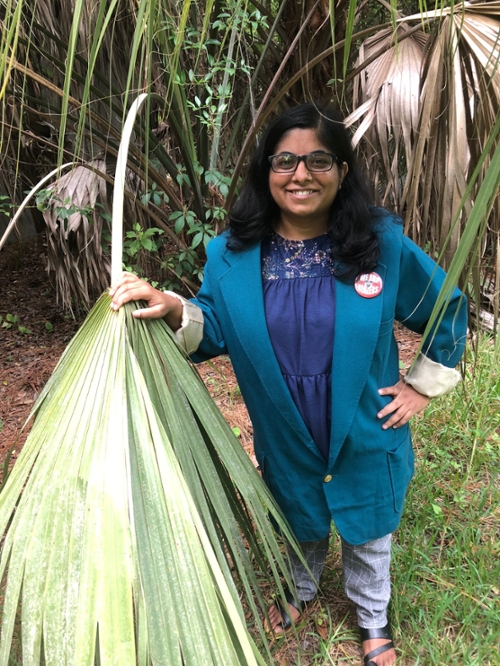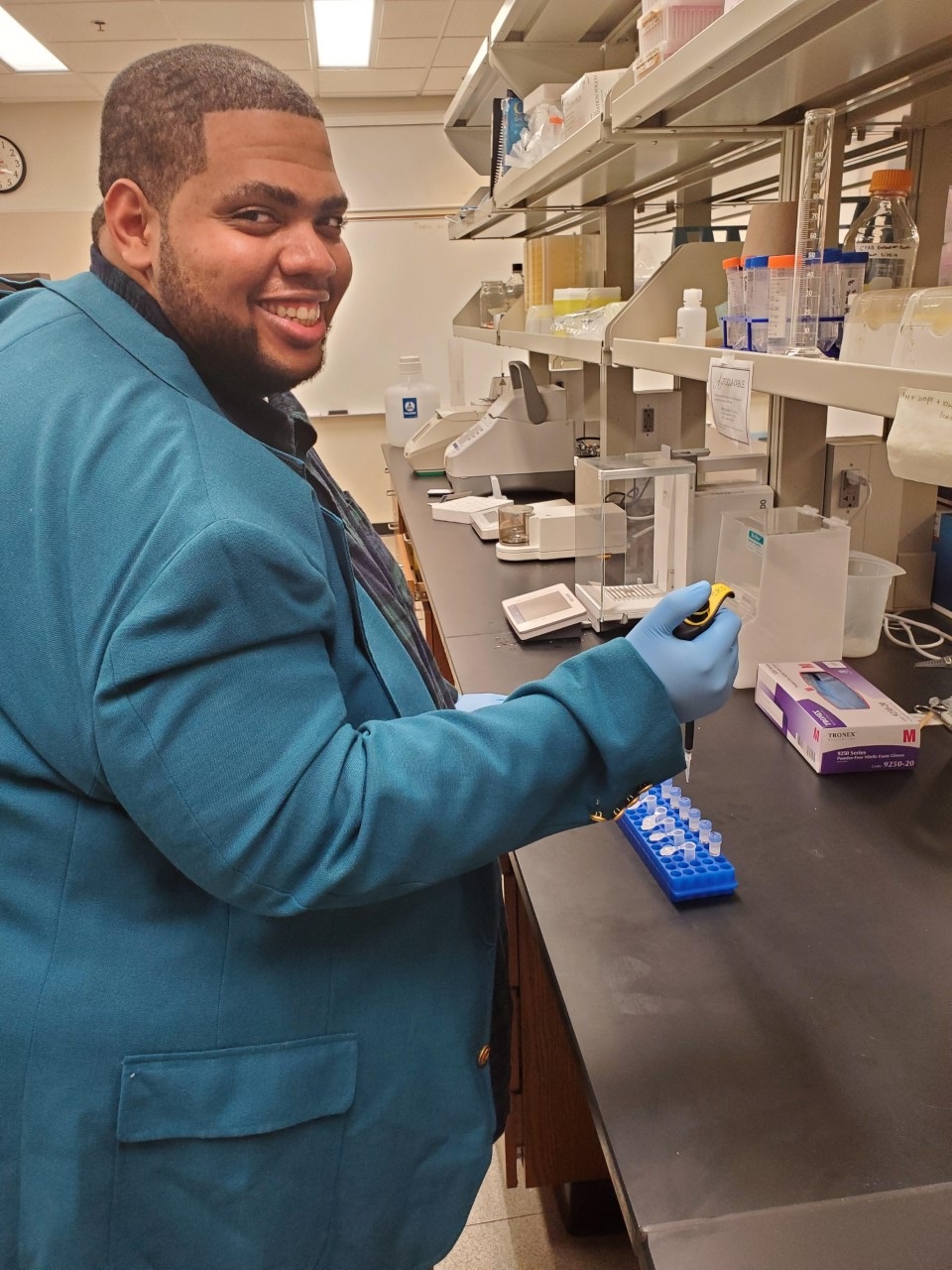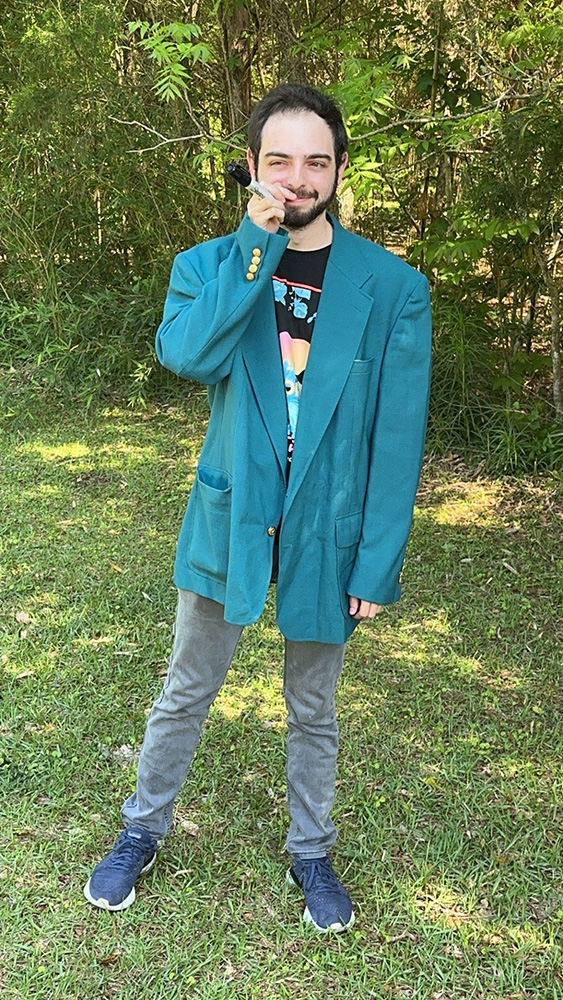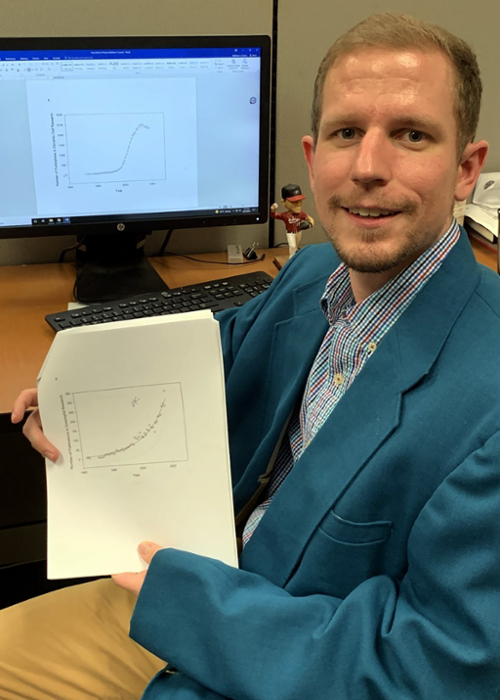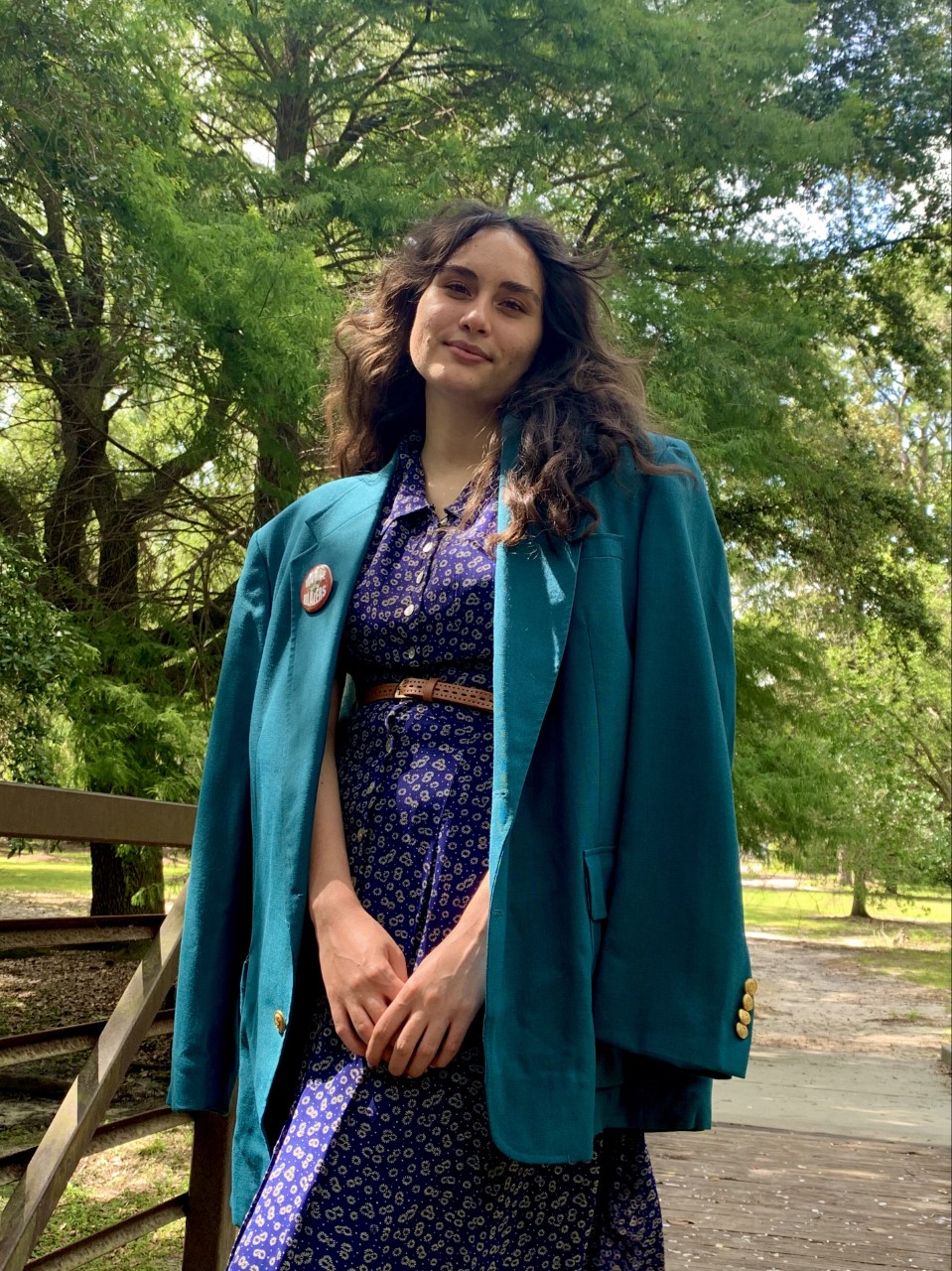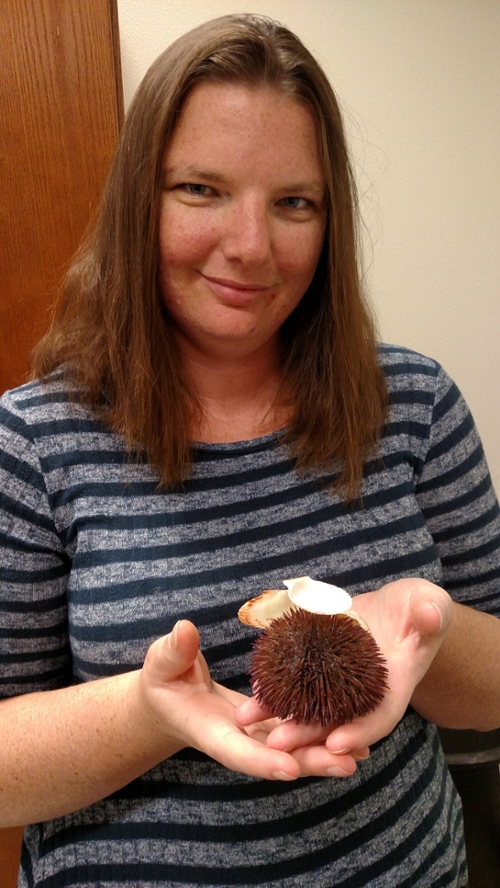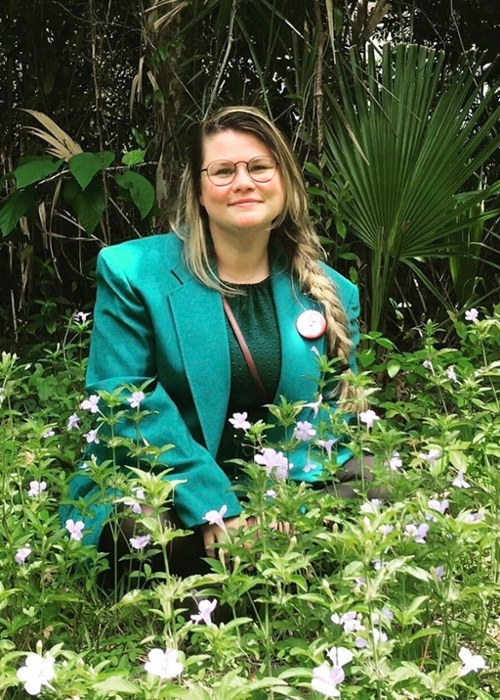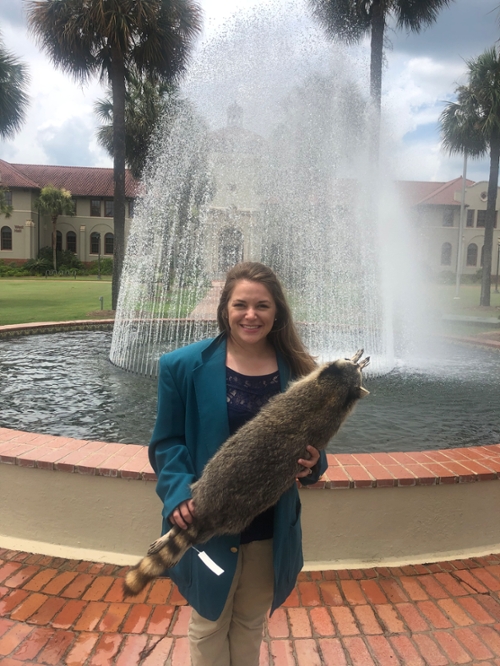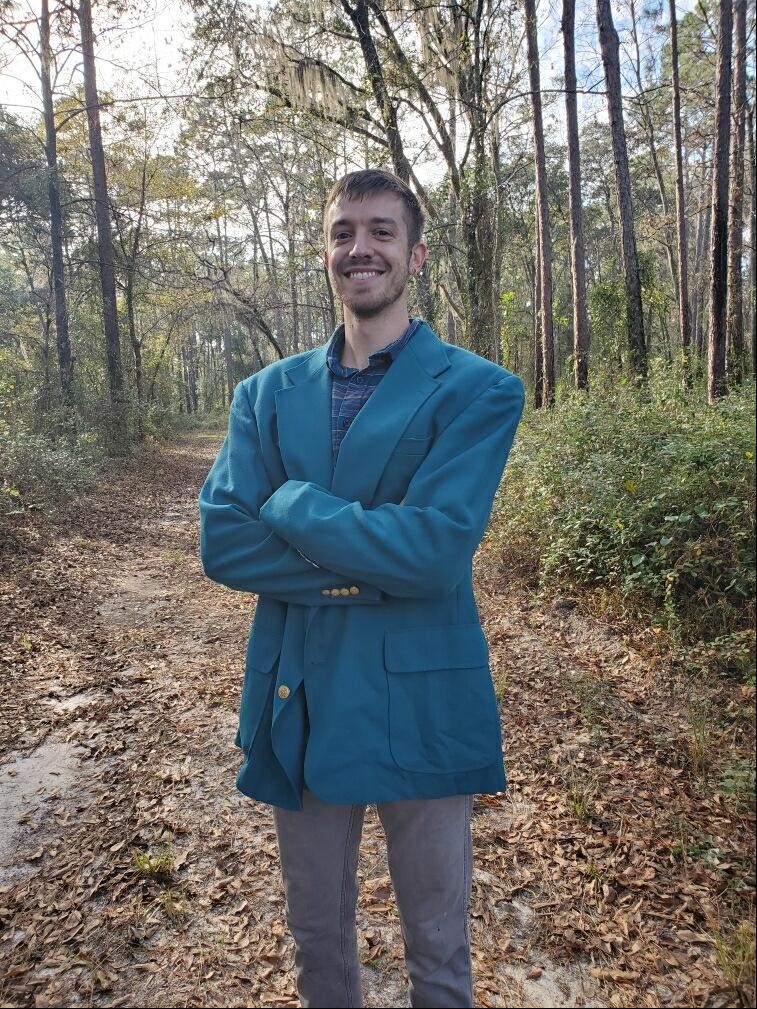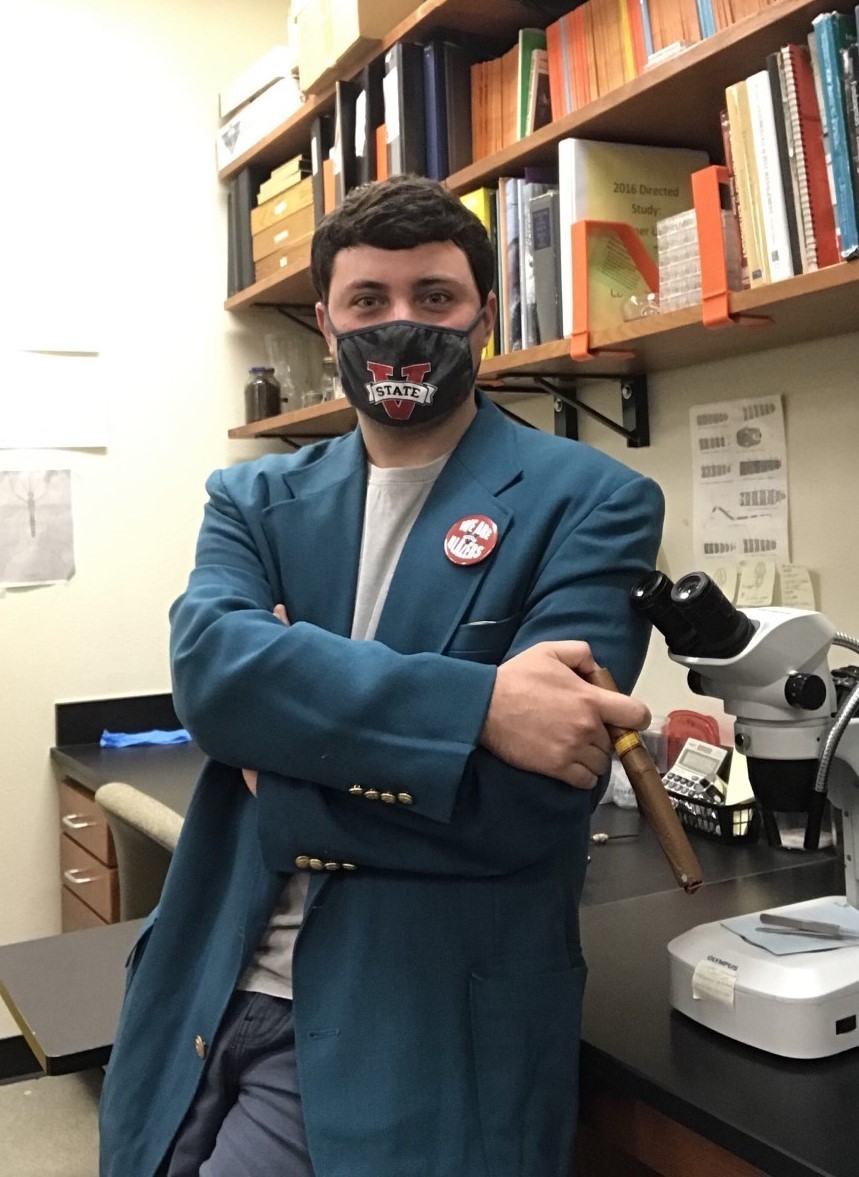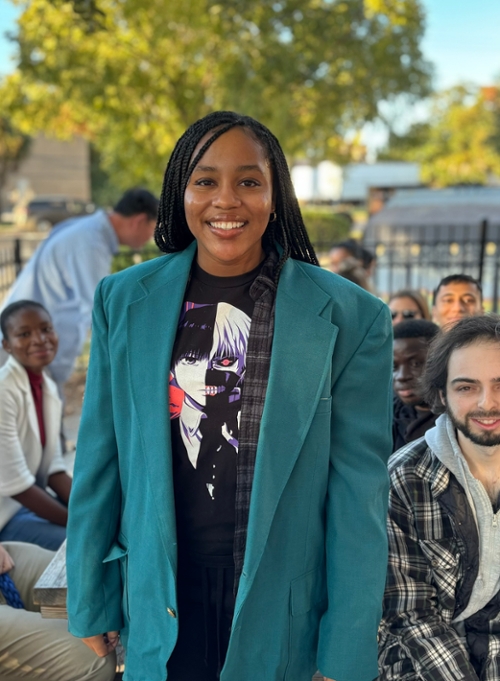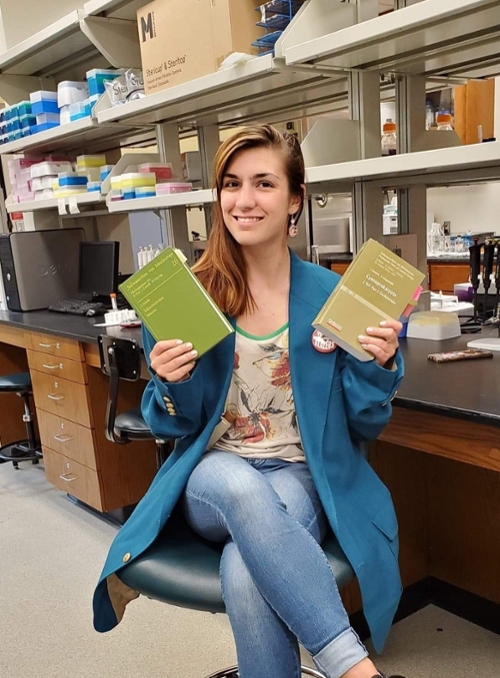Graduated Students
Name |
Title |
Abstract |
|
Fiifi Agyabeng-Dadzie Faculty Advisor: Dr. John F. Elder |
Developing Restriction Associated DNA Tags for the Ion Torrent Personal Genome Machine |
The identification and classification of similar cryptic species such as Kryptolebias marmoratus and Kryptolebias ocellatus, as distinct species has always been problematic within the biological sciences. Though Kryptolebias marmoratus and Kryptolebias ocellatus are both known to be self-fertilizing hermaphrodites, out crossing has been observed resulting in heterozygous offspring. Recently, a viable hybrid (Gitmo) between K. marmoratus and K. ocellatus has been isolated in the Valdosta State University aquatic lab. This hybrid questions the proposed species status of these fishes. Classifications of organisms are usually based on both morphological and genotypic studies. Based on morphological studies, both fishes were thought to be synonymous because of very similar anatomical and physiological characteristics. Mitochondrial studies (genotypic analysis) of these fishes have suggested otherwise. Unfortunately, thorough whole genome studies are very expensive and labour intensive. Methods such as Restriction Fragment Length Polymorphisms (RFLP), Amplified Fragment Length Polymorphisms (AFLP) and microsatellite analysis are more commonly used. These methods, though helpful, make analyses based on the length polymorphisms of the DNA fragments and only a small portion of the genome. Furthermore, surveys yield a very limited amount of genetic information. A more reliable method of analyzing large numbers of these genotypic markers concurrently would be extremely valuable for taxonomic questions. Developing Restriction Associated DNA Tag (RADTag) genome sequencing using methods for the Ion Torrent Personal Genome Machine (PGM) provides a way not only to cut down the cost of genomic sequencing but also provides a method that performs thousands of Single Nucleotide Polymorphisms (SNP) analyses at once, without the use of a reference sequence. Analysis of RADTag sequences on public domains “Stacks” software displayed thousands of markers present in the Hon9 (Kryptolebias marmoratus) genome and confirms the Hon9 strain to be highly homozygous (0.999) across all loci. This achievement paves the way for further genomic studies with high throughputs and accuracy. This RADtag genome will provide the information needed for resolving the questionable relationship between K. marmoratus and the presumptive K. ocellatus cryptic species. Key words: (RAD-Tags, SNP analysis, AFLP, RFLP, cryptic species) |
|
Arjun Adhikar Faculty Advisors: Drs. Michael Smith and James A. Nienow |
Impact Assessment of Deepwater Horizon Oil Spill and BP Dispersants on Diatoms at Perdido Bay and Pensacola Bay. |
A primarily taxonomical study was conducted to assess the distribution of diatoms after the Deepwater Horizon oil rig explosion in the Gulf of Mexico, April 20, 2010. The study is focused on the possible effects of the Deepwater Horizon oil spill on diatoms. Sampling was conducted on bimonthly basis for six months at Perdido Bay and Pensacola Bay, starting 24 September, 2010, and ending 10 May, 2011. Samples were collected from the surface as net plankton, sediment, and as whole water. Global Positioning System (GPS) was used to keep a record of exact locations of sampling. Physical characteristics such as water temperature, dissolved oxygen (DO), light intensity, salinity, and turbidity were taken at the time of sampling. Samples were preserved in Lugol’s iodine to avoid further growth and were transported back to the lab for further testing. The primary objectives of the study was diatom community characterization, comparing datasets with previous studies, and recording the number of deformed diatom valves possibly attributed to the Gulf of Mexico oil spill. A total of 524 species were encountered contributing to 90 genera. Species diversity was measured using the Shannon-Wiener index. Relative abundance of species was also calculated by counting at-least 400 valves in on transect per slide for each sample. To characterize the community structure, PRIMER-E ver. 5.0 was used to assess the Bray-Curtis similarity index and to perform multidimensional scaling, and principal component analysis. The result showed a high diversity and variability in the Perdido/Pensacola Bay ecosystem and an insignificant number of the deformed valves (<<0.01%). |
|
Kier Ancona Faculty Advisor: Dr. William J. Loughry |
Time Budget Analyses of Wild Nine-banded Armadillos |
Nine-banded armadillos exhibit obligate polyembryony, whereby they produce litters of genetically identical quadruplets by repeated twinning of a single fertilized egg. High levels of altruism have been predicted among these clonal littermates, yet intensive long-term field studies have revealed no evidence of this. The "time constraints" hypothesis attempts to explain these findings by arguing that armadillos are precluded from evolving complex social interactions, such as altruism, because of their evolutionary history. That is, armadillos have very low metabolic rates, eat low quality, widely scattered prey, and have very short active periods, so they may not have the time to be social. I collected data relevant to this hypothesis from May-July of 2007 and 2008 at Yazoo National Wildlife Refuge, Hollandale, Mississippi. Focal animal observations lasting up to 10 min were obtained from marked armadillos during two 7 h time periods: 16:00-23:00 and 23:00-06:00. Supplementary scan data were collected at first sighting of animals during the first of these time periods. I present data describing the general pattern of armadillo time budgets, as well as sex, age, temporal and environmental influences on time allocation. A comparative analysis of time budgets in other mammals was also performed to determine where armadillos fall relative to other species. My findings showed that nine-banded armadillos spent almost all of their active time feeding with little variation in time budgets. My study represents the first detailed description of armadillo time budgets and should shed light on the validity of the time constraints hypothesis. |
|
David M. Arancibia Facutly Advisor: Dr. Cristina Calestani |
Effects of starvation on the gametogenesis of the marine mussel Geukensia demissa |
Most mussel species are considered dioecious, but some species are hermaphroditic. Geukensia demissa, believed to be dioecious, is a common native mussel species on the eastern coast of North America. Mytella charruana, an invasive species, is hermaphroditic and specifically has an alternative reproduction strategy, and may outcompete G. demissa. M. charruana has the ability to reverse sex from female to male during starvation conditions. The objective of this research is to determine if G. demissa has a similar sex reversal mechanism. G. demissa was collected from Thunderbolt, GA and Jekyll Island, GA. An initial sample dissection was used to determine the sex ratio occurring in the population. Remaining mussels underwent an acclimation period, then two regimens: a control (fed) and a starvation treatment for 23-25 days (Thunderbolt, GA and Jekyll Island, GA) and 40-43 days (Jekyll Island, GA). Sex ratio was determined using gross morphology for each treatment. Histological preparations of tissue obtained from dissections were done to analyze the effects of starvation on gonadal tissue. Chi squared analysis comparing sex ratios for each treatment to 1:1 were significant for an initial dissection replicate (p=0.0177) and a 40-43 day control experiment (p=0.0295) both with a female bias. Chi Squared contingency table results from 23-25 day Thunderbolt, GA dissections indicated a significant difference between the control and starvation treatment and the initial dissection with a male bias (p=0.0362; 0.030 respectively). The 40-43 day experiments had a significant difference between initial and control treatment (p=0.040) with a female bias. One way ANOVA on percent differences comparing before and after treatment indicate a shift from a lower percentage of females to a higher percentage of undetermined (p=0.010) for the control treatment (Thunderbolt, GA).The percentage of undetermined increased while percentages of females and males decreased for control and starved after 40-43 days of treatment (Jekyll Island, GA) (p=5.37 x 10-6 control, p=0.00001 starved). Our data indicate G. demissa does not have a sex-reversal mechanism in response to starvation but most likely resorbs or spawns gametes. Since invasive M. charruana reproduces in favorable conditions regardless of season, then it may outcompete G. demissa in its native habitat. Environmental managers may need to remove M. charruana to preserve species diversity of the area. |
|
Namrata Bhandari Faculty Advisor: Dr. Colleen McDonough |
Impact of Microhabitat Selection on Burrow Distribution of Nine-Banded Armadillos and Gopher Tortoises in a Pine Plantation |
Nine-banded armadillos and gopher tortoises cohabit pine forests in the southeastern United States but may compete for burrowing locations. This may be problematic because gopher tortoises are a declining species. To examine how these two species may coexist in the same area, a microhabitat selection study measuring habitat parameters was carried out at Moody Air Force Base near Valdosta, GA. In addition, preference of habitat parameters was compared between burrow categories, such as armadillo burrow types based on location (on berm and off berm) and gopher tortoise burrow types based on age of occupant (hatchling, juvenile and adult). Eighty-six burrows were randomly selected and a discriminant analyses was used to identify parameters that differentiate the locations of both species' burrows from each other and from random sites (N = 250). Armadillo burrows (N = 40) were found in areas with higher vegetation density, greater canopy cover, steeper slopes and thicker ground cover than gopher tortoise burrows (N = 46). Steeper slopes, low visibility and farther distance from edges separated armadillo burrows from random sites. Armadillo prefer to build burrows on berms that have steeper slopes, higher vegetation density, higher ground cover, less sunlight and lower elevation than off berm burrows. In addition to the microhabitat study, I determined the detectability of different types of burrows by comparing burrow surveys conducted prior to and after a prescribed burn. Gopher tortoise juvenile and hatchling burrows and those of armadillos off berm had low detectability during the pre-burn survey. Adult gopher tortoise burrows had higher visibility than other burrow categories. This is the first study to provide evidence that synoptic armadillos and gopher tortoises prefer to build burrows in different microhabitats. This spatial niche partitioning was probably related to their physiology. Competition may be occurring because of the presence of coopted burrows and might suggest a complex or mixed mechanism to explain coexistence. Further study could be undertaken to understand why armadillos coopt gopher tortoise burrows and whether microhabitat requirements of coopted burrows are different from either species. |
|
Lauren A. Binns Faculty Advisor: Dr. Corey Anderson |
Spatial genetic structure of the nine-banded armadillo in western Mississippi |
The nine-banded armadillo is unique for producing multiple embryos derived from a single fertilized egg (polyembryony), resulting in the production of four genetically identical offspring. Juvenile littermates are known to maintain close proximity to one another during their first summer above ground, but it is uncertain if they remain together as adults. Typically in armadillo populations adults disperse, which may be due to inbreeding avoidance and/or resource competition. There have been multiple studies that have examined sex-biased dispersal in armadillos, but with conflicting results as to which sex disperses. The goal of the present study was to determine whether spatial genetic structure diminishes at a certain life stage (juvenile, adult) within a population and if there are any detectable differences in the degree of genetic structure between the sexes. Genomic DNA from a total of 402 individual armadillos was isolated from ear clip tissue from a wild population of armadillos inhabiting the Yazoo National Wildlife Refuge, Mississippi. Individuals were grouped based on age (juvenile, adult) and further subdivided between the sexes (male, female) for each age group. Genetic measures of spatial autocorrelation based on eight microsatellite loci were used in correlograms to resolve patterns of spatial genetic structure within this population. My results show significant spatial genetic structure in juveniles (both males, females) and adult males, but not adult females. These results support either female-biased dispersal or high variance in male reproductive success (via polygyny). However, further work is required to discriminate between these two possibilities. |
|
Michael J. Bland Faculty Advisor: Dr. Brian C. Ring |
The Development of a piggyBac-based Transformation Vector Useful in Fish Species. |
The transposable element piggyBac is a highly versatile and efficient method of transforming DNA sequences into cells or organisms. My work demonstrates the first step towards transformation of piggyBac-mediated DNA sequences into the germ-line of the zebrafish Danio rerio, an important and widely used model organism, and the first piscine species to be transformed by this technique. A piggyBac construct along with the piggyBac transposase supplied in the form of mRNA was microinjected into early-stage zebrafish embryos. The piggyBac construct contains DNA sequences arranged into three selection cassettes. The KanR cassette allows for antibiotic selection in prokaryotes while the HygR cassette allows for eukaryotic selection. The third cassette contains a dominant cytoskeletal actin promoter upstream of the green fluorescent protein that causes many cells in the fish to glow green when expressed. Establishing piggyBac’s utility in zebrafish raises the possibility of its use in other fish species, specifically the self-fertilizing hermaphrodite mangrove killifish, Kryptolebias marmoratus. Genetic factors controlling hermaphroditism in this fish are not well understood, and genetic transformation allowing gene over-expression or insertional mutagenesis is important for understanding genetic mechanisms controlling this unique mode of reproductive biology. To establish K. marmoratus as a model organism capable of genetic transformation aquaculture techniques were established to maximize embryo output at the earliest possible stage of development. Thirty-two different fish were surveyed for overall embryo production and developmental stage of eggs laid, resulting in 1,814 embryos observed and staged. These fish were found to increase egg production under a high-feed diet versus a low-feed diet. Differences in fecundity and embryonic stage were also observed among different clonal genotypes. |
|
Joshua I. Brown Faculty Advisor: Dr. Anderson
|
Population Genetics of Vascular Epiphytes; Optimization of DNA Extraction and Cross Species Transference in Tillandsia usneoides |
Vascular epiphytes are found in more than 70 different families and make up 9-10% of the 290,000 described species of vascular plants. Despite their significant contribution to vascular flora diversity, they have received far less attention in population genetic studies than their terrestrial counterparts. This study had three goals: (I) Provide a comprehensive literature review on the population genetics of vascular epiphytes to answer questions such as, which taxa have been surveyed and where did these studies take place? What types of molecular markers have been used? What types of population genetic measures have been reported? And what are the general findings across different taxa? (II) Develop a DNA extraction technique for an ecologically and culturally important epiphytic plant, Tillandsia usneoides (Spanish moss) that produces high yields of DNA while also minimizing possible contaminants that could affect downstream processes. (III) Asses the utility of cross-species transference as a method to develop usable microsatellite DNA primers for T. usneoides. In the literature review, I found only 25 published studies in 13 journals that studied population genetics of vascular epiphytes, representing three taxonomic families in seven countries and four continents. To date, seven types of molecular markers have been used. Interestingly, these markers do not follow typical usage trends observed in other groups, with allozymes being used more frequently than microsatellite DNA, and with no published studies to date that have used SNPs. Taxonomic and geographic biases in the population genetic literature reflect general patterns observed in the ecological literature, with most studies conducted in North America and focused on Orchidaceae (41%), Polypodiaceae (36%) and Bromeliaceae (23%). Due to the diversity of life history strategies observed in epiphytes, it is difficult to generalize population genetic results across taxa; nevertheless, in ferns, there was evidence of high gene diversity and genotype frequencies that conformed to Hardy-Weinberg expectations, whereas results were more variable for orchids and bromeliads. For the DNA extraction study, we found that a modified CTAB extraction produced the highest yield and quality DNA. Utilizing extracted DNA from T. usneoides, cross-species transference of microsatellite primers from seven different taxa in the family Bromeliaceae was assessed. Of the 36 primer sets that were screened, we identified 15 loci that produced fragments that were close in size to what was reported in the primer notes, but only 7 of the 15 loci produced polymorphic loci without other apparent abnormalities. For the seven loci the number of alleles ranged from 2 to 12. Although limited in number, the primer sets that we identified should be sufficient for assessing broad scale population genetic patterns in T. usneoides. |
|
Matthew Cannister Faculty Advisor: Dr. David Bechler |
A Survey of the Fish Fauna of the Withlacoochee River in South Georgia |
A 45 site ichthyofaunal survey of the Withlacoochee River was conducted in 2009 and 2010 employing seining, gill nets, fish traps, trot lines, fishing poles, creel surveys, and searches of existing ichthyology collections for data on the Withlacoochee River drainage. The survey yielded 51 fish species, of which 3 (Alosa alabamae, Micropterus notius, Pteronotropis metallicus) were labeled species of concern in Georgia, and 2 of those species (Alosa alabamae and Micropterus notius) are currently listed on the IUCN (International Union for Conservation of Nature) red list of threatened species, but insufficient information is available on these species to classify them federally through the Endangered Species Act. The first known sympatric populations of Elassoma evergladei and the recently described Elassoma gilberti were found at one location. Other species of a conservation concern found in the drainage basin were the invasive Lepomis cyanellus and a putative hybrid between Cyprinella venusta and possibly Cyprinella lutrensis. Multidimensional scaling using PRIMER 6 and statistical analyses demonstrated differences in species composition as a function of stream order. |
|
Damion A. Castellano Faculty Advisor: Dr. Emily Cantonwine |
Comparing Nothopassalora personata pre-infection development, colonization, and haustorial characteristics between susceptible and resistant peanut genotypes. |
Nothopassalora personata is the fungal causative agent of late leaf spot in peanut and causes premature defoliation if not controlled. N. personata is a hemi-biotroph that uses specialized hyphae called haustoria to take nutrients from the plant cells during the biotrophic phase. A new method was developed to characterize haustoria associated with lower epidermal cells of peanut leaves. Phenotypes related to resistance were measured including, the distance of the farthest haustoria from the edge of the lesion, the distance of the farthest colonizing hyphae, number of haustoria per unit area, and size of haustoria. The susceptible genotype had significantly fewer haustoria per unit area in the larger lesions, but not in the smaller lesions. Colonizing hyphae extended farther in the susceptible genotype in larger lesions. |
|
Matthew Cowan Faculty Advisor: Dr. Jonghoon Kang
|
Quantitative Analysis of Publication Numbers Over Time for Immunology Research Topics in Molecules, Cells, and Organs |
Research scientists, medical professionals, and the academic community publish their findings every year culminating in time series publication numbers of data that form nonlinear trends over time. Understanding these trends would allow researchers to predict future levels of need and interest into specific research areas within their discipline. The problem with studying these trends is defining exactly what their quantitative behavior will be in the future. Trends in publication frequency can be described by plotting sub-discipline publication numbers over time. In this study, we assign specific sigmoidal equations to each sub-discipline studied by doing a Boolean search of PubMed for publication numbers on research topics related to six molecules, ten cell types, and four organ types all related to immunology. These gathered data was simplified into a CSV (Comma-Separated Values) file that is downloaded and studied using SigmaPlot (version 11, Systat Software Inc, San Jose, CA, USA). Our approach was to transform the original data by reduction of the x-axis and then curve fit the original data set to the best fitting curve which could be analyzed by non-linear regression. This technique allowed us to apply Occam’s razor to reduce the mathematical expressions found using non-linear regression analysis to their smallest value which we believe is essential to arriving at an accurate prediction of the expected number of publications. Our findings are that immunological publication numbers of cells, molecules, and organ types in immunology have exhibited significant trends that give R2 values higher than 0.95 and that in all our areas of study only sigmoidal trend behaviors are observed. We propose that demonstrated trends in publications counts will be informative to researchers allowing prediction of growth of interest in their respective fields of study in immunology. We can also affirm that any predictions made based upon the observed sigmoidal model of future publication numbers can be verified by chi-square analysis if another study seeking the same results were to be attempted following the same methods seen in this study. |
|
Christine Chessler Faculty Advisor: Dr. J. M. Lockhart |
Gopher Tortoise Hatchling Demography and Adult Burrow Thermal Profiling at Reed Bingham State Park, Cook County, Georgia |
Research into the early life stages of the gopher tortoise has been minimal due mainly to high mortality rates of tortoise eggs and hatchlings. Over an 18-month period, hatchling dispersal and variability were studied. Temperature fluctuations within nest aprons and burrows were monitored to determine potential effects on embryo survival and tortoise thermoregulation, respectively. Surgically implanted 134.2 kHz, 8.5 x 2.12 mm PIT tags were placed into hatchlings (N = 174) that were artificially brooded during the 2008 and 2009 breeding season for identification upon recapture. Burrow temperature ecology was monitored through the placement of Thermocron iButtons connected to PVC-tubing, which is presented as a novel method for data collection. Thermal profiles showed temperature fluctuations to be greatest at the mouth of the burrow when compared to the relatively stable temperature of the deepest part of the burrow during all months observed. Furthermore, temperature fluctuations of natural nests typically were marginal when compared to that of artificial nest fluctuations in this study. Through limited recapture observations, it was found that hatchlings had no clear preference for refuge, directionality, or overall distance when dispersing from their natal burrows. Most recaptures (63%) took place during the afternoon hours (12:00-17:00), and during the months of March and October. These results coincide with optimal foraging and basking hours, as well as seasonality associated with post-hatching and post-over wintering events. Significant size and measurement variability was observed between the 2008 and 2009 hatchlings, which may be a consequence of climatic variability between years. In summary, this work provides demography data, as well as burrow and nesting ecology concentrated on a life stage of the gopher tortoise often under represented. The results and methodology of this project have the potential to be useful in various conservation programs directed at managing this threatened species. |
|
Benjamin L. Clubb Faculty Advisor: Dr. Ted A. Uyeno |
Powering the Hagfish “Bite”: A Comparative Morphological Investigation of the Hagfish Feeding Apparatus Retractor Complex |
: Hagfish use forceful retractions of a dental plate to shear and ingest food. Retractile force is generated by the retractor complex of the posterior hagfish feeding apparatus. While gross morphological descriptions exist, the organization of muscle and connective tissue fibers that form the soft tissue retractor complex do not. In this study, paraffin histology was used to prepare serial sections of Pacific (Eptatretus stoutii) and Atlantic (Myxine glutinosa) hagfishes. Digitized sections were segmented and fitted to volumetric scans of the retractor complexes taken prior to microtomy to generate three-dimensional reconstructions. These models confirm that the retractor complex is composed of a perpendicularis muscle that fits within the eye of a needle-shaped clavatus muscle, which anteriorly bears the dental plate tendon, and in turn fits within a sleeve-like tubulatus muscle. Analysis of fiber orientations within these muscles resulted in novel functional hypotheses: 1) The tubulatus muscle represents a novel tubular bi-pennate muscle with a considerable physiological cross-sectional area. Its activation may indirectly create tension in the dental plate tendon: as the tubulatus muscle forcefully extends, it displaces the terminal bulb and the clavatus muscle posteriorly. 2) Within the terminal bulb, the muscle fibers of the clavatus and perpendicularis muscles are mutually perpendicular and may co-contract to form a swelling stopper knot that resists being pulled through the tubulatus muscle. 3) While overall muscle morphology is conserved, the physiological cross-sectional area of the tubulatus muscle in E. stoutii, is relatively larger than that of M. glutinosa, suggesting a more forceful retraction. The tubular bi-pennate construction of the tubulatus may represent a novel soft robotic actuator design. |
|
Braxton Crews Faculty Advisor: Dr. James Nienow |
Ecotoxicological Effects of Lithium Chloride on Lyngbya wollei
|
Lyngbya wollei is a filamentous cyanobacterium that plagues freshwater environments of the Southeastern United States because it impedes freshwater navigation and recreation, and produces harmful cyanotoxins along with a foul odor. Current treatment plans for L. wollei blooms include numerous biological and mechanical methods, while chemical control is primarily limited to application of copper- and aluminum-based compounds that often have significant negative side effects. Here, we investigate the potential of lithium compounds as control agents for L. wollei. Lithium is not expected to bioaccumulate, has terrific bioremediation potential, and is relatively non-toxic, exhibiting qualities that make it an excellent candidate for an agent of chemical algal control. In this experiment, cultures of L. wollei were exposed to lithium chloride in concentrations increasing up to 400 mg/L. Additionally, filamentous freshwater green algae were also treated with lithium chloride, in order to gain some insight into the specificity of lithium chloride for L. wollei. In a separate set of experiments, L. wollei filaments were exposed to the antibiotics streptomycin, tetracycline, and isoniazid, and to equivalent concentrations of potassium chloride. Filaments were checked for damage using a light microscope, and PAM-fluorometry was used to investigate changes in photosynthetic activity. The effect concentration of lithium chloride was determined to be between 100-200 mg/L for L. wollei and >400 mg/L for freshwater green algae. The antibiotics did not effectively damage the filaments, but the potassium chloride solution produced damage at the effect concentration of lithium, indicating a promising field for further investigation. PAM-fluorometry results suggest that the mechanism by which lithium chloride damages and kills cells in the filaments is unrelated to photosynthesis- the effects observed could be attributed to seasonal variation in L. wollei. In the highest concentration treatment group, freshwater microorganisms were observed, suggesting that lithium chloride may be a safe and effective means of chemical control of freshwater cyanobacteria, pending further experimentation. |
|
Sean M. Earley Faculty Advisor: Dr. Matthew N. Waters |
The Paleolimnology of Long Pond, GA, USA: Linking Biogeochemical Processes and Historic Primary Producer Communities |
Many freshwater resources have experienced intense and recent stress from human development as well as changes from historic climate alterations. As a result, an understanding of natural water resources needs to be placed within a framework of past climate, environmental, and anthropogenic stressors in order to forecast future change and effectively manage these ecosystems. The primary objective of this research was to reconstruct limnological conditions prior to human development in order to determine anthropogenic and climate caused ecosystem change. Paleolimnological techniques on a 5m core collected from Long Pond, GA, USA were applied to investigate three objectives: 1) Determine the paleolimnological history of Long Pond. 2) Reconstruct the historic primary producer community in response to allochthonous inputs over time. 3) Determine the biogeochemical and limnological mechanisms governing trophic dynamics in Long Pond. Long Pond existed in three distinct zones spanning the past ~6000 years. The lake began as a wetland and developed into a lacustrine environment around 4000 YPB. The early lake period included increased connectivity with the surrounding watershed and low productivity. Modern lake conditions began around 1200 YBP and included high levels of phosphorous and metal deposition but moderate levels of primary productivity. As a result, in-lake dynamics must be regulating the trophic status of Long Pond. Low concentrations of available phosphorous in the water column combined with high concentrations of sedimentary phosphorous may imply the binding of phosphorous to the sediments by certain materials such as aluminum and iron. Another explanation for the modern day control of eutrophication may be nitrogen limitation. Bioassays using photosynthetic pigments conducted in Long Pond identified co-limitation of primary productivity by both phosphorous and nitrogen. |
|
Emily E. Evans Faculty Advisor: Dr. Mark Blackmore Secondary Advisors: Drs. Eric Chambers and Mitch Lockhart |
Surveillance of Permethrin Resistance in Valdosta Populations of Aedes albopictus via the CDC Bottle Bioassay |
Mosquito populations are likely to develop genetic resistance to insecticides with prolonged and/or improper application. Regular assessments of insecticide resistance should be performed on exposed populations to optimize local integrated mosquito management strategies. Current strategies within Valdosta, Georgia, especially chemical insecticide application, may prove to be outdated and inefficient due to the absence of a designated resistance testing center. The current study aims to provide a baseline resistance report for the nuisance biter and potential disease vector, Aedes albopictus (Skuse) to the type I pyrethroid, permethrin. Although Ae. albopictus is primarily a nuisance biter in southern Georgia, this species has the physiological potential to be a vector of numerous arboviruses and other pathogens. Ae. albopictus colonies were established from eggs collected at 15 independent sites within and near Valdosta, GA between July and November of 2019. The majority of the sites were located in residential neighborhoods. Post-rearing, survivability upon permethrin exposure was tested using the Centers for Disease Control and Prevention (CDC) Bottle Bioassay Kit. This bioassay accounts for resistance by comparing a ‘diagnostic time’ (the maximum time required to kill 100% of susceptible mosquitoes of a particular species and insecticide dosage) to the actual time taken for experimental mosquitoes to die. The occurrence of permethrin resistance in Valdosta populations of Ae. albopictus was observed in this study. According to World Health Organization (WHO) standards, <90% mortality at the diagnostic time indicates resistance, and mosquitoes from all 15 collection sites exhibited mortality <82%. This level of resistance suggests that mosquito abatement methods currently used in Valdosta, Georgia should be modified to mitigate insecticide resistance. Population reduction of this potential vector species should then reduce the risk of rapid disease transmission should the respective pathogens be introduced into the area. |
|
Samantha A. Gimbel Faculty Advisor: Dr. Tim Henkel |
The energetic cost to the sea urchin Lytechinus variegatus from dynamic pH environments when subjected to long term maintenance at a static low pH and A survey of sea urchin populations at Gray’s Reef National Marine Sanctuary |
Coastal zones have a natural dynamic chemistry that can be exacerbated by anthropogenic ocean acidification, potentially leading to negative impacts on calcifying organisms. Populations of the sea urchin Lytechinus variegatus occur along the western Atlantic Coast and the Gulf of Mexico, including in habitats that experience periodic natural ocean acidification. This study assesses the ability of L. variegatus to cope with the potential increased energetic demands of adapting to prolonged ocean acidification by comparing urchins living at one of two pH levels, 8.0 (current) and 7.5 (low), for three months. The stress responses measured were 1) total amount and rate of oxygen consumption, 2) travel distance and velocity of movement, 3) elapsed duration of righting response, and 4) energy allocation to reproduction based on gonad index. No significant difference was found in any variable; however, there was substantial variation in the gonad index and the righting response. The lack of any differences supports the hypothesis that adult L. variegatus occupying habitats with natural short term pH fluctuations can potentially mitigate negative impacts associated with long term occupation of an acidified environment. |
|
Adarsh Gopinath Faculty Advisor: Dr. John F. Elder |
Relationship Between Cannabinoid Receptor 1 Gene Variation and Behavioral Differences Among Kryptolebias marmoratus Laboratory Isogenic Lines |
The endocannabinoid system (ECS) is a cellular signaling system composed of molecules that include endogenous cannabinoids (endocannabinoids), membrane bound receptors called cannabinoid receptors and the enzymes that regulate the concentration of endocannabinoids. In human beings and other vertebrate models the ECS is implicated in the regulation of several bodily functions from appetite control to processing rewards. Cannabinoid receptor 1 is a G-protein coupled receptor encoded by cnr1a gene. It forms an integral part of the ECS. Polymorphism in the cnr1 gene in humans is associated with substance addiction, depression, anorexia and several other mental disorders. Kryptolebias marmoratus is a neotropical synchronous self-fertilizing hermaphroditic teleost that has been documented to produce clonal progeny in isolation. A behavioral study has managed to separate isogenic K. marmoratus labstrains across a shy-bold continuum. In descending order of boldness, K. marmoratus labstrains Vol, Rhl, 50.91 and Hon 9 were chosen to have the cnr1 gene sequenced from archived genomic DNA samples and analyzed for polymorphism. The coding region of cnr1 was found to be monomorphic among all four labstrains tested and highly conserved across several vertebrate species. Although no association could be established between the coding region of cnr1 and variation in boldness, further studies characterizing genetic control elements, rates of transcription and tests for the presence of post-transcriptional modification in cnr1 mRNA among the labstrains need to be performed to better understand the relationship between this gene and the boldness trait in K. marmoratus. |
|
Brandi Griffin Faculty Advisor: Dr. Corey Anderson |
Biomechanics and functional morphology of Tillandsia usneoides |
Tillandsia usneoides (Spanish moss) is a pendent epiphyte that can propagate by vegetative breakage or sexually by seed. Tension tests, morphometrics, and X-ray imaging to were used to elucidate the mechanism of node breakage in T. usneoides, and to evaluate how node properties vary across strands. Tension tests revealed that the internode is up to four orders of magnitude stronger than the node. Nodal area decreased slightly along a strand even though the cross sectional area of the central tensile element did not change. Node strength increased with node position, but was lower for nodes that contained flowers. The estimate of the intercept term did not vary much across different strands of T. usneoides, and the effect of a change in nodal position was also consistent across strands. The fracture point morphology was diagrammed from X-ray images and scanning electron micrographs. This combination of qualitative and quantitative analyses could lead to new technologies inspired by biological solutions for tension loaded materials. |
|
John Griner Faculty Advisor: Dr. J. Nienow |
A Study on the Diversity of Subaerial Algae in Southern Georgia: Two Possible New Species of Coelastrella (Chlorophyta, Chlorophyceae) |
Studies on the Diversity of Subaerial Algae in Southern Georgia: Two Possible New Species of Coelastrella (Chlorophyceae, Chlorophyta) -Subaerial algae are a diverse group of photosynthetic microorganisms defined by their ability to grow on surfaces exposed directly to the air. They are especially common in humid regions, including parts of southern Georgia. We have studied a number of strains isolated from southern Georgia maintained in unialgal culture as part of a larger effort aimed at a) determining the diversity of subaerial algae and b) elucidating the mechanisms enabling them to thrive in an environment with limited access to liquid water. Genetic and morphological investigations of two previously unidentified strains, VSU 102 and VSU 114, indicate that they may represent unknown species of green algae. An analysis of the nuclear 18s rRNA gene commonly used in phylogenetic studies placed one of the strains (referred to as VSU 114) in close proximity to Coelastrella saipanensis (Chlorophyta, Scenedesmaceae) and Coelastrella vacuolata (Chlorophyta, Scenedesmaceae). Morphological data, including the presence, number, and structure of meridional ribs in the cell walls, suggest that these taxa are distinct and should possibly be considered separate species. Analysis of the 18s rRNA gene in strain VSU 102 placed this strain in close proximity to Coelastrella multistriata (Chlorophyta, Scenedesmaceae). Although Coelastrella multistriata and VSU 102 differ genetically by their 18s rRNA content, no morphological differences could be determined. Thus, VSU 102 may represent a cryptic species of Coelastrella multistriata. |
|
William A. Haney Faculty Advisor: Dr. Theodore Uyeno |
Characterization of Body Knotting Behavior in Hagfish |
Hagfishes possess a flexibility that allows them to form body knots and then slide the knots along their body. This behavior enhances the hagfish’s ability to clean mucous off their body, escape tight spaces, pull prey from burrows and possibly replace the leverage commonly generated by an opposing jaw. Despite the importance of this knotting behavior to the survival of hagfishes, very little has been reported in the literature. This is probably due to the difficulty of studying the behavior in the wild. Using a novel hagfish restraint device, consistent and reliable knotting events were captured with high-speed bi-planar video. I used these recordings to characterize the type and kinematics of knots made by 3 species belonging to the 2 families of hagfishes: Eptatretus stoutii, Eptatretus springeri, and Myxine glutinosa. I found that hagfishes statistically preferred simple knots despite the higher internal stresses that these knots theoretically induce. Also, despite the behavioral stiffness (does not coil) of E. springeri and M. glutinosa when compared to E. stoutii (coils) there was no statistical difference in looseness of knots tied when comparing radii of loops between species. However, decreased stiffness may be beneficial: E. stoutii was able to tie more complex knots than the other two species. The hagfish body represents an extremely flexible hyper-redundant system that may require a high level of neural input for control. However, kinematic video analysis reveals a potential elegant solution: hagfishes seem to employ only three body movements (crossover the body, tail-wrap, and tail insertion into a loop). These three motions can be re-ordered to create the entire diversity of observed knots as well as more complex theoretical knots. Furthermore, statistical analysis suggests that these motions were performed in the same manner across all species. This study suggests that knotting may be efficiently controlled by motor primitives and sets the stage for neurophysiological investigations. |
|
Jaelle Hector Faculty Advisor: Dr. James Nienow |
N/A |
NON-THESIS GRADUATE |
|
Philip Wayne Hightower Faculty Advisor: Dr. David Bechler |
The Life History of the Crayfish Procambarus spiculifer in the Alapahoochee River |
A fifteen month life history analysis was conducted on a population of Procambarus spiculifer in the Alapahoochee River. The crayfish P. spiculifer inhabits lotic waters in portions of Georgia, Florida, and Alabama. Cephalothorax lengths ranged from 6.07 mm to 59.80 mm and weights varied from 0.02 g to 53.37 g. The mean sizes of adults were 45.90 mm for form I males, 42.77 mm for form II males, and 38.43 mm for mature females. Form I males and mature females were collected year round. Relationships of cephalothorax lengths with body weights, chelae lengths, cephalothorax widths, ovarian eggs, and abdominal eggs were examined. Cephalothorax width and chelae width comparisons among sex classes were also performed. Peak juvenile introductions into the population occurred in June, late fall, and early winter. A maximum life span of two to three years was determined. Reproductive maturity occurs around the ages of 12 to 15 months. The mean for ovarian egg counts was 602 eggs (n = 61) and the mean for abdominal egg counts in the laboratory was 464 eggs (n = 6). Abdominal egg diameters had a mean of 1.74 mm (n = 120) with a range of 1.04 mm to 2.03 mm. Females have the ability to reproduce more than once and new ova begin development immediately after a clutch of eggs is laid. The right vas deferens is probably the only functional one in P. spiculifer. GSIs were determined for mature females, immature females, form I males, and form II males. A gastric stomach analysis revealed that both males (n = 20) and females (n = 20) consume more vegetal matter than animal matter in their diet. |
|
Willie D. Hill Faculty Advisor: Dr. Jonghoon Kang |
Statistical Analysis of Thermodynamic Quantities in the Binding of Ligands to Bovine and Human Serum Albumin
|
Albumin is one of the most studied proteins because of its diverse functions (Peters, 1995). Albumin varies between species, but past research on Human Serum Albumin (HSA) and Bovine Serum Albumin (BSA) has shown structural similarities between the two. Binding properties of HSA and BSA can be compared using the thermodynamic parameters of enthalpy, entropy, and Gibbs free energy (ΔH, ΔS, and ΔG). Previous studies have shown a linear relationship between enthalpy and entropy when temperature is held constant (enthalpy-entropy compensation). Prior data used thermodynamics to compare the two proteins on a micro-level (1-10 ligands). This thesis is the first to statistically analyze thermodynamic quantities in the binding of ligands to HSA and BSA on a macro-level (200+ ligands). A bioinformatic approach was used to obtain thermodynamic data from 197 primary literature sources available in PubMed (Sayer, et al., 2022). Linear regression was applied and showed a significant positive correlation between enthalpy and entropy in both proteins examined. The findings indicate the existence of a significant enthalpy-entropy compensation. This thesis quantitatively described the variation of ΔH°, ΔS°, ΔG° in the binding of ligands to BSA and HSA by using Cumulative Distribution Function (CDF). The obtained CDFs were used to derived Normalized Probability Density Function (NPDF) for each thermodynamic quality. The Shannon entropy was calculated to assess the variability on ΔH°, ΔS°, ΔG°. The resulting values of Shannon entropy shows that both ΔH° and TΔS° have larger values than that of ΔG° for both proteins. ΔG° contained lower levels of information (uncertainty) than ΔH° and TΔS° for both proteins. |
|
Amber N. Holley Faculty Advisors: Drs. Chambers, Blackmore, Lockhart and Grabarczyk
|
Disease Surveillance of Dirofilaria immitis and West Nile Virus in Mosquitoes in Lowndes County, Georgia | Dirofilaria immitis, the causative agent of canine heartworm disease, and West Nile virus (WNV) are both mosquito-borne pathogens. Mosquito surveillance and vector determination are crucial in understanding the transmission of these pathogens which helps implement methods of control to prevent and predict outbreaks. In this study I assessed the ability of the Anopheles quadrimaculatus complex to transmit D. immitis and investigated the influence climate and land use and land changes (LULC) have on WNV transmission in Culex quinquefasciatus mosquitoes, the primary vector in the Southeastern United States. Standard PCR and an L3-specific RT-PCR protocol were used to assess D. immitis infection rates in An. quadrimaculatus mosquito samples. To determine the influence of climate and LULC on WNV from 2012-2021, data were collected from Weather Underground and the VSU WNV Mosquito Surveillance lab. Results from this study suggest that the An. quadrimaculatus complex is a potential vector of D. immitis and that urbanization and temperature influence WNV transmission by mosquitoes in Lowndes Co., GA. |
|
Sarah E. Hough Faculty Advisor: Dr. Mitchell Lockhart |
Metal Accumulation in a Terrestrial Mammalian Assemblage in Southeastern United States |
Metals occur naturally in the environment and are essential for physiological processes in animals, however, an increase in tissue metal concentration above threshold levels can cause adverse effects. Determining baseline tissue metal concentrations in terrestrial species can thus increase our understanding of the impact of metal contaminants and anthropogenic activity on wildlife. Unfortunately, baseline metal tissue concentrations in many terrestrial mammals have not been extensively studied. Liver samples from armadillos, bobcats, coyotes, feral cats, grey foxes, opossums, and raccoons were collected from four sites, which experienced relatively similar levels of human disturbance in Georgia and Florida, over four years. Samples were analyzed for multiple metals and concentration differences were analyzed by age (juvenile vs adult), sex, site, species, and year collected. The metal tissue concentrations of raccoons were comparable to previous published studies. When examining the mammal assemblage collectively, there were no consistent, specific patterns to explain the accumulation of metals in liver tissue based on trophic levels. This study provides reference values for eight metals that can be used for future studies. |
|
Dallas Ingram Part-time Student Faculty Advisor: Dr. J. M. Lockhart |
Effects of Commercial Poultry Operations on Diseases in Wild Turkeys (Meleagris gallopavo) in South Georgia |
Wild turkeys are susceptible to most of the same diseases that affect domestic poultry. In 2004, a large commercial poultry company announced that it would be building a chicken processing plant and hatchery in Cook and Colquitt Counties in Georgia. Hunter killed and sick or dead wild turkeys were submitted to the Veterinary Diagnostic and Investigational Laboratory in Tifton, Georgia from 2005 through 2008. Turkeys were examined grossly for lesions and tested for parasites, bacteria and viruses to determine if the introduction of commercial poultry production to south Georgia would adversely affect the health of the wild turkey population, and, if so, how widespread this effect would be. A significant difference was seen between years for eastern equine encephalitis serum neutralization test, West Nile polymerase chain reaction (PCR), St. Louis PCR, number of protozoans, degree of parasite infection, Newcastle disease virus serology, health score and serology health score. Significant change was also noted between the control group (Madison County) and the test group with the number of nematodes, the degree of parasite infection, and the health score. When comparing locations, a significant difference was noted for Salmonella sp. bacterial culture, nematodes, and parasite degree of infection. This is the first report of avian encephalomyelitis virus antibodies and parvovirus in wild turkeys.
|
|
Taylor Jarvis Faculty Advisor: Dr. Gretchen Bielmyer |
At elevated concentrations, marine organisms may accumulate metals, which can potentially cause toxicity. Metal accumulation and toxicity in aquatic organisms has focused largely on waterborne metal exposure and less research has focused on dietary metal exposure. In addition to dietary metal exposure, an important emerging class of contaminants within marine ecosystems is nanoparticles (NPs). This research investigated the accumulation and effects of dietary metals and NPs in marine invertebrates. Two seaweed species, Ulva lactuca and Agardhiella subulata, were each concurrently exposed to five metals (Cu, Ni, Pb, Cd, and Zn), and U. lactuca was also exposed to the metal mixture as well as each metal individually for 48 h. The seaweeds were then used as food for the sea hare, Aplysia californica. Body mass of A. californica was measured and metal concentration was quantified in dissected organs. Metal accumulation in the organs of A. californica varied with different metal species. A. californica demonstrated significantly reduced body weight by the end of the exposure periods, as compared to controls. In addition, the diatom, Thalassiosira weissflogii was exposed to ZnO NPs for 7 d and growth, zinc accumulation, and zinc distribution was measured within the algal cells. The ZnO-exposed diatoms were fed to the copepod, Acartia tonsa for 7 d and reproduction and survival were quantified. Zinc accumulation in the algae occurred dose-dependently over time. Feeding on ZnO-exposed diatoms led to a decrease in copepod survival and reproduction. These results highlight the significance of dietary metal exposure in lower trophic levels and support the use of A. californica as a sensitive bioindicator species of metal pollution in marine systems as well as provide evidence of trophic transfer of metal contaminants associated with metal oxide NPs within a marine plankton community leading to the reduction in individual demographic performance of an important coastal marine grazer. | |
|
Gerard Johnson Faculty Advisor: Dr. John F. Elder |
Phylogeny of the freshwater crayfish sub-famly Cambarinae based in 16S RDNA gene analysis. |
Freshwater crayfish have been a mainstay in biological experiments as a model species ever since Huxley’s (1880)seminal publication The Crayfish. Crayfish have been used in research ranging from vision pigment studies to neural physiology. Non-native species have been introduced on four continents due to their immense economic value. Although crayfish taxonomy is reasonably well resolved at the highest levels there are some problems at the levels of genus and species. New exploration, technology and methodology have lead to the discovery of not only new species but a phylogenetic complexity that would have not been imagined in Huxley’s era. This complexity is caused by the conservatism of some morphological characters, high intraspecific diversity and convergence. The ambiguity of crayfish taxonomy is visibly evident for species native to South Georgia and North Florida, which are centers of crayfish diversity. Molecular phylogenetic analyses were employed to provide insight into three aspects of crayfish phylogeny. Using data from the 16s ribosomal gene, we determined (1) the evolutionary relationships of a previously unanalyzed species, Procambarus spiculifer, (2) relationships within the genus, Procambarus, and (3) the phylogeny of the entire sub-family Cambarinae. The resulting trees of the Neighbor Joining, Maximum Parsimony, and Minimum Evolution analyses are all consistent with the hypothesis that their phylogenies are significantly different than the traditional systematic representation of relationships within the subfamily. The subfamily Cambarinae is not divided into the three distinct clades according to their genus of Procambarus, Cambarus, and Orconectes in any of the analyses. |
|
Christopher Le Faculty Advisor: Dr. Jack M. Lockhart
|
Survival assessment and movement analysis of gopher tortoises (Gopherus polyphemus) in south Georgia, USA |
The keystone and threatened status of the gopher tortoise (Gopherus polyphemus) makes them a species of interest for wildlife management. Two studies were conducted on gopher tortoises in south Georgia. The first study assessed the survivability of 174 passive integrative transponder (PIT) tagged gopher tortoise hatchlings released in 2008 and 2009 at Reed Bingham State Park (RBSP), Cook County, Georgia, USA. It was hypothesized that 10% (17/174) would be recaptured. From March 2020 to July 2021, release sites Gopher Tortoise Management Area and Pioneer Site were surveyed. Zero (N = 0) of the 174 PIT-tagged hatchling tortoises were recaptured. Suggestions for recapture failure were predation, human presence, detection difficulty, dispersal away from release sites, and Upper Respiratory Tract Disease. The second study analyzed movement activity of an adult male gopher tortoise utilizing Global Positioning System (GPS) technology at Moody Air Force Base, a military installation in Lowndes and Lanier Counties, Georgia. Movement was GPS-tracked from September 2020 to January 2021. GPS data contained location, temperature, and satellite-specific acquisition information. A total of 263 (N = 263) Fixed Locations (FL) were acquired. FL were analyzed for home range, core area, distance >300 m, and nocturnal movement (20:00 – 05:00). Home range increased 10-fold with increasing horizontal dilution of precision (HDOP) (range: 3.55 – 15.86 ha, HDOP ≤ 1.5 – 9.9), core area was 0.13 ha, greatest straight-line distance was 345 m, and 41 nocturnal events occurred. GPS unit troubleshooting and gopher tortoises’ fossorial nature attributed to early battery life depletion and FL accuracy and precision analysis. Most FL occurred in the core area; long distance movement outside the core area was exhibited five times, one included nocturnal movement. Suggestions for long distance movement were habitat quality, overwinter burrowing, reproduction, social interaction, and energy expenditure recovery. |
|
Dariana N Rodriguez Kesler Faculty Advisor: Dr. Eric Chambers |
Vector-Host Prevalence Comparison of Cytauxzoon felis in south Georgia and north Florida |
Cytauxzoonosis is an infectious disease caused by the protozoan parasite Cytauxzoon felis that affects members of the family Felidae. Cytauxzoon belongs to the phylum Apicomplexa, order Piroplasmida, and family Theileriidae. Members of this family are tick-transmitted protozoans that exist in erythrocytic and leukocytic stages in their intended hosts. Historically, the disease was thought to be fatal to domestic cats, but recent cases of host survival have been documented. Studies on the genetic variation of the first and second internal transcribed spacer regions (ITS1 and ITS2) of the rRNA operon have identified five prominent genotypes (ITSA, ITSB, ITSC, ITSG, ITSI) associated with varying cytauxzoonosis severity in the bobcat and domestic cat. Little research has been done so far to uncover how these genotypes are expressed in the vectors of the pathogen, Amblyomma americanum (lone star tick) and Dermacentor variabilis (American dog tick). A number of studies have shown A. americanum to be a more competent vector in the wild. In this study PCR and gel electrophoresis were used to test for the presence of C. felis in blood samples from Felis catus (domestic cat), and the vector A. americanum. After testing for the presence of the parasite in each blood sample, positive samples were DNA sequenced in an attempt to identify distinct C. felis genotypes. Previously genotyped Lynx rufus (bobcat) DNA samples were used as positive controls and for comparison purposes. A total of 109 domestic feral cat samples were collected for this study from June 2019 to February 2020, and a total of 260 lone star tick samples were collected from March 2020 to May 2020. Of the collected samples eight samples from domestic cats and 17 from lone star ticks were sent to Florida State University for DNA sequencing. DNA sequence results showed that our samples were infected with more than one pathogen, the three genera within the order Piroplasmida were identified (Babesia sp, Theileria sp, and Cytauxzoon sp).
Keywords: Cytauxzoon felis, domestic cat, Amblyomma americanum (lone star tick), Georgia, Florida, PCR |
|
Travis Key Faculty Advisor: Dr. David Bechler |
Juvenile Fish Usage of Limulus Breeding Depressions in an Intertidal Mudflat |
Horseshoe crab (Limulus polyphemus) breeding behavior results in the presence of sediment depressions in intertidal zones. Water exits the intertidal at low tide and juvenile fish inhabit these water-filled depressions which retain water until the subsequent high tide. Depressions vary in size, presence of vegetation (eelgrass, Zostera marina), and prey (zooplankton and meiobenthos). The purpose of this research was to analyze fish composition as species and number in depressions and to determine if depression occupation was based on fish being stranded in the depressions on the intertidal or if depressions were being selected based on depression characteristics. In Summer 2008, data collection in Port St. Joseph Bay, Florida included species of fish, number of fish, sediment surface area, water volume, vegetation, zooplankton and meiobenthos for each depression sampled. AIC was used to establish models with fish number and mean fish size as dependent variables and surface area, volume, vegetation, zooplankton, and meiobenthos as independent variables. These models were applied at assemblage, population and individual ecological levels. The most abundant species were Cyprinodon variegatus and Fundulus similis, which represented 61.1% of all fish. The mean standard length of each of these two species fluctuated over time reflecting possible breeding events. The composition of fish in depressions compared to depressions characteristics indicated that occupation is behavior specific for each species. Selection was based on depression size, vegetation presence or absence, and prey types. Selection factors varied based on mean standard length of fish and species. This research indicates the importance for Limulus presence in intertidal ecosystems as their breeding behavior may increase the survival of juvenile fish. |
|
Joseph (Ashley) Kirkley Faculty Advisor: Dr. David L. Bechler |
Biogeography and Population Genetic Structure of the Water Moccassin, Agkistrodon piscivourus, in the Alapahoochee Watershed |
This study examines the biology of the Water Moccasin, Agkistrodon piscivorus conanti, in the Alapahoochee watershed, Lowndes and Echols Counties, Georgia. Included is a biogeographical investigation incorporating population genetics, a diet survey, a length/weight relationships analysis, sex ratio analysis and observations on reproductive ecology. Collections occurred over a two year period in 2008 and 2009. Data recorded in the field and laboratory included location, sex, snout-vent length, weight, gut contents and condition of the snake at time of collection. DNA was extracted and analyzed based on published microsatellite primer pairs for Crotalus contortix and cross amplified in Agkistrodon piscivorus that were tested for use in our study. Overall sex ratios did not deviate from the expected in this study but, were definitely skewed relative to the year collected and location from which they were collected. The majority of guts examined had no contents, and the remainder had small meals suggesting snakes were foraging at the time of capture. Length-weight relationships were comparable for both males and females. Presence of eggs and embryos showed that ovulation occurs in May followed by a 3 to 4 month gestation period with birth occurring by end of August. The genetic analyses in this study involve only three microsatellite loci and limited numbers of individuals per population. One locus, CH4B, was highly divergent between populations indicating that the populations sampled may be exhibiting restricted gene flow. |
|
Ashlie Kuliy Faculty Advisor: Dr. Jonghoon Kang |
Statistical Analysis of Sequence Characteristics of Single Transmembrane Cluster of Differentiation Proteins: A Study of Functional Relevance |
Cluster of Differentiation (CD) proteins are human white blood cell markers involved in immune reactions. They are used as targets for immunological studies, diagnostic techniques of disease states as well as utilized in therapeutic applications for cancers and other maladies of the body. Analysis of sequence characteristics of CD proteins has enabled the identification of functional trends that may be useful in understanding their roles within the immune system. Through statistical analysis, Principal components analysis (PCA) and K-means clustering, 36 Type II CD proteins were analyzed by one hundred twenty-four biochemical and biophysical properties derived from amino acid sequences alone. The analysis revealed these 36 CD proteins can effectively be grouped into two distinct known functional groups. In addition, possible unknown functional properties of CD71 have been identified specifically. This research shows the potential for a quantitative approach in proteomics to unlock predictive capabilities. It is believed that upon the basis of this analytical technique, functional properties may be predicted of currently undiscovered CD proteins as well as known, poorly characterized CD proteins. |
|
Blake Lamb Faculty Advisor: Dr. Corey Anderson |
Comparison of Gopher Tortoise and Nine-Banded Armadillo Associate Fauna |
Burrowing organisms are ecosystem engineers that augment the availability of resources for other species. Throughout the Coastal Plain of the southeastern United States the gopher tortoise (Gopherus polyphemus) is a keystone species in open canopy pine-forest ecosystems as its burrows are utilized by over 360 species. These species are responsible for numerous ecosystem processes that maintain ecosystem functionality and health. Across its current range, the gopher tortoise is in decline and has been listed as a vulnerable species by the International Union for the Conservation of Nature (IUCN). Declining tortoise abundance negatively impacts the populations of species that depend on tortoise burrows which will, in turn, have negative impacts on ecosystem function. The introduced nine-banded armadillo (Dasypus novemcinctus) is another burrowing species of similar size that is highly abundant and syntopically distributed with the gopher tortoise. Recent research has found high diversity of vertebrates utilizing armadillo burrows, implicating that armadillos support local biodiversity in a similar manner as gopher tortoises. I compared vertebrate visitation between armadillo and tortoise burrows in a mixed-pine hardwood forest at the Lake Louise Field Station in Lowndes County, Georgia using motion activated game cameras placed at equal numbers of burrows produced by each excavator species. I also tested for burrow and microhabitat effects on visitation by associate vertebrates and investigated patterns of metacommunity nestedness within the study area. A total of 40 vertebrate taxa were observed visiting burrows between October 2019 and December 2020. Species richness, biodiversity, and community composition were not significantly different between burrow types. However, total visitation was significantly greater at tortoise burrows as well as visitation frequency for 15 taxa. Burrow and microhabitat variables showed varying effects on burrow visitation for different categories of vertebrates. Most notably, vertebrate visitation frequency was positively affected by tortoise burrows, active burrows, and increased tree species richness while consistently negative effects were observed for increased canopy cover and high proportions of hardwood trees. Patterns of nestedness were not found to correspond with any applicable environmental variable. This research provides a unique framework for comparing utilization of habitat features, adds information to the growing body of work on the ecological effects of the nine-banded armadillo’s range expansion, and pinpoints aspects of the habitat that relate to the importance of burrows for other species. My study also highlights and reinforces the ecological significance of the gopher tortoise and suggests that armadillo control efforts may need to be considered on a case-by-case basis. |
|
Matthew L. Cowan Faculty Advisor: Dr. Jonghoon Kang |
Quantitative Analysis of Publication Numbers Over Time for Immunology Research Topics in Molecules, Cells, and Organs |
Research scientists, medical professionals, and the academic community publish their findings every year culminating in time series publication numbers of data that form nonlinear trends over time. Understanding these trends would allow researchers to predict future levels of need and interest in specific research areas within their discipline. The problem with studying these trends is defining exactly what their quantitative behavior will be in the future. Trends in publication frequency can be described by plotting sub-discipline publication numbers over time. In this study, we assign specific sigmoidal equations to each sub-discipline studied by doing a Boolean search of PubMed for publication numbers on research topics related to six molecules, ten cell types, and four organ types all related to immunology. These gathered data were simplified into a CSV (Comma-Separated Values) file that is downloaded and studied using SigmaPlot (version 11, Systat Software Inc, San Jose, CA, USA). Our approach was to transform the original data by reduction of the x-axis and then curve fit the original data set to the best fitting curve which could be analyzed by non-linear regression. This technique allowed us to apply Occam’s razor to reduce the mathematical expressions found using non-linear regression analysis to their smallest value which we believe is essential to arriving at an accurate prediction of the expected number of publications. Our findings are that immunological publication numbers of cells, molecules, and organ types in immunology have exhibited significant trends that give R2 values higher than 0.95 and that in all our areas of study only sigmoidal trend behaviors are observed. We propose that demonstrated trends in publications counts will be informative to researchers allowing prediction of growth of interest in their respective fields of study in Immunology. We can also affirm that any predictions made based upon the observed sigmoidal model of future publication numbers can be verified by chi-square analysis if another study seeking the same results were to be attempted following the same methods seen in this study. |
|
Landon T. Lassenter Faculty Advisor: Dr. John F. Elder |
Computational Studies of the Cu-taxol Complex: An Analysis of Solubility and Stability |
The natural product taxol is one of the most significant cancer drugs to date. Taxol is the sole member of a class of drugs with a unique mechanism of action. It is an effective treatment for numerous types of cancer, but one limitation to the compound is low solubility in an aqueous environment. In this computational study, taxol is bound with copper in a variety of configurations to create the Cu-taxol complex and tested using Spartan Molecular Modeling software and the semi-empirical PM3 method. The configurations generated involved either a single Cu-N bond and five Cu-O bonds (non-hydrated Cu-taxol); or a single Cu-N bond, four Cu-O bonds, and a single Cu-H2O bond (monohydrated Cu-taxol-H2O). Of the 252 configurations calculated, 4 likely non-hydrated Cu-taxol configurations and 16 likely monohydrated Cu-taxol-H2O configurations were generated for a total of 20. These resulting complexes were analyzed using the modified Aqueous Stability Factor to determine their relative solubility and their stability was found to be superior to taxol. The results also show that shifting the Cu-O bonds can drastically change the polarity of the complex, leading to the conclusion that it is a polarity adaptive molecule. |
|
Philip Lowe Faculty Advisor: Dr. Richard Carter |
Studies in the Cyperaceae of Georgia: Distribution of Georgia Sedges, Analysis of the Cyperus squarrosus-granitophilus Complex and Two New Species
|
The sedge family (Cyperaceae) is one of the most impactful families to agriculture and a key constituent of graminoid communities in many ecosystems. However, there is no full accounting of all of sedge species vouchered in Georgia. Understanding which sedge taxa occur in the state and where they exist is necessary for both effective pest management and protection of communities and species of interest. I examined holdings at the three largest herbaria in the state to inventory the state's sedge flora. For each taxon, I assessed phenology and the physiographic regions where it occurred. Along with this inventory, I did morphometric analyses of three narrow taxonomic problems. The first analyzed the relationship between the granite outcrop endemic Cyperus granitophilus and its close generalist relative, Cyperus squarrosus. In addition to confirming these species are morphometrically distinct, I discovered a new variety of C. squarrosus which is restricted to granitic uplifts of Texas and Oklahoma. I also investigated two putatively new sedge species from Georgia, one, a Cyperus restricted to exsiccated karst ponds in southwestern Georgia, and, the other, an Eleocharis restricted to high-marshes of Camden County, Georgia. My analysis supports both as distinct species. |
|
Markus B. Lowery Faculty Advisor: Dr. Joshua Reece |
A Climate Change and Sea-Level Rise Assessment and Prioritization Protocol of 20 Natural Communities in Georgia’s Lower Coastal Plain |
Human intervention in the environment has caused rapid and substantial losses in global biodiversity resulting in what many deem the 6th mass extinction. The biodiversity that remains is seriously threatened by climate change, sea-level rise and land-use changes. Conservation efforts often include both species level (fine filter) and community level (course filter) approaches. In most cases conservation resources are limited and available resources must be allocated to those species and ecosystems that are most vulnerable, biologically distinct, likely to positively respond to conservation practices, and valuable biologically, socially, or economically. Prioritization protocols in the form of vulnerability assessments are often used to assess and identify species or ecosystems of high conservation priority. We used the Standardized Index for Vulnerability and Value Assessment (SIVVA) to assess and rank 20 natural communities in the Lower Coastal Plain of Georgia based on vulnerabilities to synergistic threats and ecological, economic, and evolutionary value projected out to the years 2050 and 2100. These communities are described in The Natural Communities of Georgia, a new classification system for Georgia’s natural communities. Our results showed considerable consistency in prioritization of communities across multiple ranking schemes despite variation in uncertainty and in the value of different types of information such as historical versus future threats. Communities of high priority include Tidal Freshwater Marsh, Depression Marshes and Cypress Savannas, the Okefenokee Swamp, and Beaches, Sandbars, and Intertidal Flats. This study is the first to use this natural community classification system as well as the first usage of SIVVA in Georgia. Additionally, this study aligns with Georgia Department of Natural Resources conservation goals of assessing Georgia’s natural communities and adopting this new classification system. This thesis is formatted for publication in the Natural Areas Journal so that Georgia conservation agencies will be able to access and utilize the methods here to assist them in meeting their conservation goals. |
|
Kelly Luke Faculty Advisor: Dr. David Bechler |
"The role of dyadic interactions in the mixed mating strategies of the mangrove killifish, Kryptolebias marmoratus" |
Kryptolebias marmoratus is a small cyprinodont fish native to tropical and subtropical waters of Florida, Brazil, and the Caribbean. It is the only known self-fertilizing, hermaphroditic vertebrate and the only vertebrate to display androdioecy, a complex system of reproduction in which hermaphrodites and males are present. This study describes the repertoires of reproductive and agonistic behaviors displayed by the mangrove killifish, K. marmoratus, and examines the roles played by hermaphrodites and males in a complex mating system. The term construct is used to refer to specific pairings based on whether they involved males or hermaphrodites. 90-minute behavior observations were conducted in the laboratory on dyadic pairs of similar size K. marmoratus for two possible mating pairs and one construct involving male-male pairings: (1) hermaphrodite-male, (2) hermaphrodite-hermaphrodite, and (3) male-male. This allowed observation of behaviors that could not be observed in the field. Kryptolebias marmoratus exhibited a total of 25 distinctive acts or behaviors. Acts were divided into four categories based on the type of behavior that was performed: aggressive, submissive, neutral, and reproductive. My observations of the different pair constructs of K. marmoratus reflect on the interactions that are taking place in a community or assemblage of fish where both males and hermaphrodites occur. Leading and follow acts play an important role in the behavior repertoire of these fish. In the herm-male construct, males initiate the reproductive process entirely and actively pursue the hermaphrodite. In the herm-herm construct, there was no evidence that hermaphrodites behave like other simultaneous hermaphrodites and alternate sexual roles. Hermaphrodites are extremely aggressive towards one another and the aggressor establishes dominance immediately. The male-male construct was subdivided into two subconstructs based on the presence or absence of the caudal ocellus. It appears the presence of the caudal ocellus signals to males the possibility of a potential mating partner. However, when no ocellus occurred on either male in the construct, their behavior was similar to the herm-herm construct, in that both members of the pair were aggressive towards one another. |
|
Heera Malik Faculty Advisors: Drs. Smith and Nienow |
To investigate the community structure of diatoms of Choctawhatchee Bay in response to the BP oil spill |
The primary objective of this research was to characterize the structure of the diatom community in Choctawhatchee Bay in response to BP oil spill. Three types of samples, net plankton, sediment and whole water, were collected on a bimonthly basis for six months. Diatoms in the samples were identified at the species level whenever possible by both light microscopy (LM) and scanning electron microscopy (SEM). A total of 87 genera and 437 species were recorded; this represents approximately 40% of species previously recorded in the Gulf of Mexico. Net plankton samples were compared with historical data to determine if a significant shift in the community structure had occurred; the absence of similar data did not permit a comparison of sediment communities. Current and historical plankton associations were only 28 % similar. This low similarity could be result of natural variation in the composition of the phytoplankton, differences in sampling techniques used, differences in the application of taxonomic principles, or changes brought about by the BP oil spill. At this point we cannot distinguish which of these is the most important factor. Moreover the number of abnormal valves observed, much less than 0.1% of the total number of valves argues against a major impact of BP oil spill on the diatom community.
|
|
J. Ryce Martin Faculty Advisor: Dr. John F. Elder |
Population Genetics of Isolated Cyprinid Minnow, Pearl Dace (Margariscus margarita), on Isle Royale, MI |
In 1949, Hubbs and Lagler described morphological variation among populations of cyprinid minnows (pearl dace, Margariscus margarita) of inland lakes on the Isle Royale National Wilderness Area. For one of these lakes in particular, Harvey Lake, Hubbs and Lagler’s described a population of Pearl Dace that were morphologically distinct and argued this was sufficient to warrant subspecific status of the Harvey Lake pearl dace population. Harvey Lake is approximately 168 feet above Lake Superior’s current water level and has been isolated by elevation since the last time Lake Superior’s water level was high enough to reach Harvey Lake, approximately 10 to 15 thousand years ago when the last glaciation receded into Canada. Hubbs and Lagler argued that the morphological variation of the Harvey Lake pearl dace population is due to the isolation of Harvey Lake resulting in an allopatric genetic differentiation of the population from those found in lower elevation Isle Royale lakes and ponds. Recently the National Park Service has become concerned about the conservation of the fishes of Isle Royale. The need for genetic analyses has recently arisen to assess the extent of gene flow, if any exists, among the Harvey Lake population and the inland lakes adjacent to it. Statistical analyses of a limited battery of microsatellite loci data yields some preliminary suggestions of genetic differentiation among all populations of Isle Royale Pearl Dace inclusive of both Harvey Lake and other lowland Isle Royale populations. |
|
Elizabeth Mercer Faculty Advisor: Dr. Catherine Bush |
A worldwide Phylogenetic Analysis of Scutellaria (Lamiaceae) | The plant genus Scutellaria L. (Lamiaceae) is comprised of approximately 350 cosmopolitan species. Twenty-four species are found in the southeastern United States. The genus has been used medicinally on multiple continents, predominately for its anxiolytic, anti-inflammatory and analgesic properties. Recently, certain species in the genus have been investigated for their ability to inhabit cancer cell growth. Despite the vast interest in the group, a molecular phylogeny has never been performed on the genus as a whole. My project involves a preliminary phylogenetic analysis of Scutellaria with representative from every continent except Antarctica. DNA from field, herbaria (MO, NY, VSC) and lab specimens were extracted for a total of 30 species including one outgroup taxon, Holmskioldia sangunea. Gene regions sequenced include matK and the trnL intron + trnL-F spacer. The resulting phylogeny will provide preliminary scaffolding on which a more targeted approach to medicinal screening within the genus can be based. |
|
Miracle Mgbeahuruike Faculty Advisor: Dr. Calestani |
N/A | NON-THESIS GRADUATE |
|
Brittany Mixon Ragan Faculty Advisor: Dr. J. M. Lockhart |
Radio Frequency Identification (RFID) Monitoring of Gopher Tortoises (Gopherus polyphemus) and Investigations on the Presence of Ranavirus in Terrestrial and Aquatic Turtles in South Georgia |
A gopher tortoise (Gopherus polyphemus) population was monitored for movement detections in and out of burrows over a 9 year study, 2005-2014, using radio-frequency identification (RFID) techniques. Research using RFID techniques to monitor reptile populations is limited. RFID can be useful to researchers because it can provide a continual assessment of detecting an individual animal using a transponder and transceivers throughout the environment. For this study, I used PIT (passive integrated transponder) tags attached to the carapace of gopher tortoises, along with a transceiver and antenna located at the entrance of burrows. This equipment provided me with detection data on the movement of gopher tortoises at Moody Air Force Base, GA (MAFB) in Lowndes, County. Significant results show that male tortoises did on average visit more burrows than female tortoises and male tortoises did have a higher diversity of burrow usage. I also analyzed whether environmental parameters such as precipitation and maximum and minimum temperature levels correlated with average tortoise movement. This thesis also assessed the presence of ranavirus within the Lowndes County area of south Georgia. Ranavirus, a disease gaining global attention, has now been linked as the cause for mass mortality events in reptiles, amphibians, and fish. I collected oral swab samples from four different turtle species throughout the Valdosta area. |
|
Josephine G. Shieh Faculty Advisor: Dr. Jonghoon Kang |
Effects of Helix Dipole Membrane Field Potential Interactions on Hydrophobic Energies of Transmembrane Proteins |
The race to uncover new biological drug targets has led to an emerging field of research on the thermodynamic properties that stabilize transmembrane proteins as well as the role of these stabilizing factors in shaping the evolutionary landscape of drug target populations. When proteins are inserted into the plasma membrane, they fold into three-dimensional secondary protein structures called alpha helices. The electrical interactions within the alpha helix causes the protein to form a macrodipole. As a result of this phenomenon, the energetic stabilities of TM proteins may either be disrupted or enhanced due to the interactions between the surrounding membrane potential and the charged dipole termini of the folded helix. Currently, the relative contributions of compensatory factors to TM protein stability and their population distributions are poorly understood. In this study, two categories of bitopic proteins and the hydrophobic energies of their TM domains were investigated. We hypothesized that Type I TM proteins exhibit lower hydrophobic free energies as a compensatory response to the decreased electrical stabilities of Type I proteins that have incurred an energetic penalty due to the spatial orientations. A Z test showed that Type I proteins exhibit significantly lower hydrophobic free energies than Type II proteins (p = 0.0003, α = 0.05). A Z test of Shannon entropies of both protein types revealed that Type 1 proteins exhibit significantly lower Shannon entropies than those of Type 2 (p = 0.000, α = 0.05). Linear regression analysis showed a weak correlation between Type I Shannon entropies and Type I hydrophobic energies (R2 = 0.221) and Type II Shannon entropies and Type II hydrophobic energies (R2 = 0.232), suggesting that Shannon entropies are not a direct function of hydrophobic free energies and may arise from synergistic interactions among various energetic contributors. |
|
Christopher A. Slaton Faculty Advisor: Dr. Mark Blackmore |
Dirofilaria immitis (Rhabditida: Onchocercidae) Infection in Mosquitoes (Diptera: Culicidae) from Urban and Rural Habitats in South Georgia and North Florida
|
Dirofilaria immitis is a mosquito-borne pathogen that causes heartworm disease in dogs and other canids. To better understand the vector ecology of heartworm disease, mosquitoes were collected from 8 urban sites in Lowndes County, GA and 8 rural sites in Jefferson County, FL and tested for D. immitis DNA. The presence of infective L3-stage larvae was determined using polymerase chain reaction (PCR). Vector species composition and infection rates were compared between the two habitat types. 11 mosquito species tested positive for D. immitis infection: Aedes albopictus, Aedes vexans, Aedes infirmatus, Anopheles crucians, Coquillettidia perturbans, Culex erraticus, Culex nigripalpus, Culex quinquefasciatus, Culex salinarius, Culiseta melanura, and Psorophora ferox. Overall infection prevalence was higher among urban mosquitoes (7.27/1,000 mosquitoes, 95% CI: 4.33 – 11.30), than in rural mosquitoes (2.63/1,000 mosquitoes, 95% CI: 1.42 – 4.38). The apparent principal urban vector, Cx. quinquefasciatus, was significantly more abundant in urban locales, making up 56.2% of urban collections. An. crucians is likely the principal rural vector in this region and constituted 34.4% of rural collections. This is the first report of infective D. immitis occurring in Cq. perturbans and Cs. melanura. The varying infection rates and species compositions between urban and rural locations suggest that D. immitis epidemiology within a given geographic region is partially shaped by vector abundance differences between habitat types. In South Georgia and North Florida, transmission risk appears to differ between urban and rural areas, with urban mosquitoes posing a greater threat to susceptible vertebrate hosts. |
|
Jennifer Newsome Faculty Advisor: Dr. Brian C. Ring Funded by NIH Grant # 1R15HD060017 |
Mechanisms of Ovotestis Development in the Mangrove Killifish |
The mangrove killifish is one of the few synchronous hermaphroditic vertebrates in the world. This fish has a gonad containing both ovarian and testicular tissue, known as an ovotestis, that enables the fish to self-fertilize. The objective of this study was to use a forward genetic screen to cause mutations that disrupted ovotestis development. In this three generation screen N-ethyl-N-nitrosourea (ENU) was applied at varying concentrations to a parental generation (P) of mangrove killifish. Mortality, egg production, and fertility of the P fish were recorded over a 10-week period and compared to pre-treatment values. ENU exposures ranging from 2.8 to 3.8mM caused an initial decrease in fertility which recovered by the seventh week post-treatment (~90%). A histological examination was carried out on neoplasia found in 2 of these P fish. The first generation progeny of these fish, (F1) were screened for fertility. From 7,350 F1 embryos collected over the first 10 weeks, 1,334 F1 fish hatched and 284 were screened and allowed to self-propagate. Seventy-three of the offspring in the second generation (F2) progeny exhibited heritable zygotic mutations. A pilot screen was also conducted in which 7 F1 fish with observable mutant phenotypes were chosen to be propagated into the third generation to screen for sterility. Sterile mutants were identified by the absence of viable progeny. Two maternal-effect sterile mutants were identified as well as 1 non-egg laying sterile mutant. This study established the utility of the mangrove killifish as an effective model for embryological and early developmental studies, with the potential to investigate the genetic regulation of ovotestis development. |
|
Tatyana Nienow Facutly Advisor: Dr. Theresa J. Grove |
Functional Characterization of Calesequestrin from the Killfish Fundulus heteroclitus
|
Calsequestrin (CSQ) is the main calcium-binding protein that regulates calcium release from the sarcoplasmic reticulum in both skeletal and cardiac muscles. CSQ undergoes dramatic conformational changes upon binding and releasing calcium. While the properties of CSQ have been well studied in homeotherms, less work has been done in poikilothermic organisms. In this study skeletal muscle CSQ from the killifish Fundulus heteroclitus (FCSQ1) was sequenced, expressed, and characterized. The calculated molecular weight of FCSQ1, excluding its signal sequence, is approximately 49 kDa. The primary structure of FCSQ1 is highly conserved when compared to CSQs from other vertebrates, although its overall sequence similarity, theoretical pI (3.94), and tail length, are more similar to the cardiac isoform rather than the skeletal muscle isoform. At 15°C, pH 7.5, the KD of FCSQ1 is 0.10 ± 0.006 mM in the absence of KCl and 0.14 ± 0.018 mM in the presence of 0.1 M KCl as calculated from a fluorescence spectroscopy-based assay. This is lower than the generally reported KD of 1 mM, but is similar to the results obtained using a similar technique by Hidalgo et al. (1996). FCSQ1 also exhibits pH independence and moderate temperature dependence, suggesting that there is partial adaptation to the varying thermal environment in which F. heteroclitus is found. |
|
Antonio Ortiz Facutly Advisor: Dr. Cristina Calestani |
Transcriptional Regulation of the Pigment Cell Differentiation Gene Polyketide Synthase in the Sea Urchin, Strongylocentrotus purpuratus |
Embryogenesis is a remarkably dynamic and precisely regulated process, and the exact genetic programming that controls embryo development from fertilization to a complete organism is not fully understood. In order to understand the process of cell differentiation during embryo development we utilize the purple sea urchin, Strongylocentrotus purpuratus, as our animal model. Our objective is to gain further understanding of the gene transcriptional regulation, particularly of the Gene Regulatory Networks (GRNs) playing a role in the development of larval pigment cells, which are part of the larval immune system (Hibino et al., 2006). In order to reconstruct the pigment cells GRN we will study the cis-regulatory elements, more specifically those controlling the expression of the differentiation gene polyketide synthase (Sp-Pks) in pigment cells. Sp-Pks encodes a protein essential for biosynthesis of the S. purpuratus pigment known as echinochrome (Calestani et al., 2003). Comparative genomics was performed utilizing the software FamilyRelationsII, MEME, and SANN in order to predict cis-regulatory modules and putative DNA-binding sites in the -3kb region of the Sp-Pks promoter. The SANN and MEME analyses were done utilizing five co-expressed pigment cell genes: Sp-Flavin-monoxidase 1, 2, 3, Sp-Sulfotransferase, and Sp-Pks. Furthermore, we compared them in two additional sea urchin species: Allocentrotus fragilis and Strongylocentrotus franciscanus. From these analyses we selected putative sites to test via site-directed mutagenesis within the -3kb promoter. We then utilized the Yeast-One-Hybrid system to identify putative transcription factors that bind to the Sp-Pks promoter. The characterization of all the regulatory elements that control the transcription of Sp-Pks both spatially and temporally will allow for further understanding of the developmental gene regulatory network upstream of this terminal differentiation gene. |
|
Chase Patrick Faculty Advisor: Dr. Matthew Waters |
Ecological Impacts of Benthic Biota and Sediment Materials on Lake Seminole, Georgia, USA |
Human impacts on river systems include dam construction, inputs of sediments, eutrophication and the introduction of non-native species. These stressors can alter biogeochemical cycles, change trophic structures, and decrease ecosystem services. Specifically, non-indigenous invasive species can change ecosystem services, cause loss of biodiversity, and alter biogeochemical processes. I implemented a wide range of limnological and paleolimnological techniques to investigate anthropogenic impacts on a large shallow reservoir, Lake Seminole, GA, USA. This study established that dense populations of the invasive clam, Corbicula fluminea, can play an important role in linking pelagic and benthic environments within a large shallow reservoir. I also established that cyanobacterial macrofossils can be recovered and used to investigate historical nutrient and toxin storage and production. Additionally, this study indicates that when macrophytes are eliminated there is a drastic increase in phytoplankton biomass, that infers to be co-nutrient limited. |
|
Jacob L. Perry Faculty Advisor: Dr. Brian C. Ring While employed full-time at Landis International Funded by NIH Grant # 1R15HD060017 |
Cloning, Characterization, and Expression Analysis of the Vasa Gene form Kryptolebias marmoratus | Kryptolebias marmoratus, formerly known as the Mangrove Rivulus, has been studied in the laboratory setting since the late 1950’s. K. marmoratus is a selfing hermaphrodite with a unique gonad, termed the ovotesties, consisting of both ovarian and sperm tissue. One particular gene of interest to the development of this gonad is the vasa gene. Vasa is an ATP-dependent RNA helicase, which has been studied in many different organisms such as: Drosophila melanogaster (fruit fly), Homo Sapiens (humans), Ambystoma mexicanum (salamander), Xenopus laevis (frog), Danio rerio (Zebrafish), Oryzias latipes (medaka), and Strongylocentrotus purpuratus (sea urchin). The vasa gene was cloned and sequenced from K. marmoratus. The gene consist of 2,273 nucleotiedes, a predicted amino acid sequenced of 641base pairs, and a 3’ untranslanted region (UTR) of 234 base pairs in length. BLASTp and phylogenetic analysis revealed that the kmvasa gene is closely related to T. oreintalis (Pacific blue fin tuna) and has a close relationship to O. latipes (medaka). The ATP-dependent RNA helicase vasa protein was detected in only the gonad region of K. marmoratus hermaphrodites and males. In other species, the vasa gene is also expressed at similar levels throughout embryogenesis. Key words: (ovotesties, vasa ATP-dependentRNA helicase, UTR, phylogenetic analysis,and QPCR) |
|
Pramir, K. C. Faculty Advisor: Dr. Jonghoon Kang |
Analysis of Amino Acid Sequence Characteristics of Type I Cluster of Differentiation (CD) Proteins Using Multivariate Statistics to Determine Their Functional Class. |
Cluster of Differentiation (CD) proteins are proteins found in the cell membranes of leukocytes. These proteins are important because they are cell surface markers for many immune cells and can be used as therapeutic and diagnostic targets. Biophysical methods like X-ray crystallography and nuclear magnetic resonance (NMR) are commonly used to determine the function of proteins through the generation of their three-dimensional structures. However, applications of these experimental methods do not work very well in order to determine the function of membrane proteins because of their high flexibility and instability, their partial hydrophobic surface, and the requirement of highly specific detergents for their extraction from phospholipids membranes. In order to address this problem, we devised a theoretical approach where type I CD proteins can be classified into two different functional groups (enzyme and non-enzyme) by using physicochemical parameters related to the primary sequence of the individual CD proteins. Principal component analysis (PCA) was used to analyze 126 parameters of 244 type I CD proteins. Two different clusters of type I CD proteins with enzymatic activity and non-enzymatic activity were found on the score plot, and the separation of those clusters was found to be statistically significant. Cytoplasmic amino acid count was found to be the most important variable for separating enzymes and non-enzymes. The continuous probability densities of CD proteins with enzymatic activity and non-enzymatic activity were then approximated by kernel density estimation (KDE) of cytoplasmic amino acid count. This is the first time this method of determining type I CD proteins functional classes has been employed and appears quite promising. In the future, this statistical approach could be very useful in determining the functional class of newly discovered or poorly characterized type I CD proteins. |
|
John Salter Faculty Advisor: Dr. David Bechler |
Fish Assemblage Structure in Lentic Vegetated Microhabitat in South Georgia | Aquatic vegetation provides multiple resources such as shelter, food, and breeding habitats for many fish species. Fishes that occupy habitats with similar ecological characteristics are described as fish assemblages. However, not all vegetation offers the same set of resources. Therefore, I hypothesize not all fish assemblages that occupy aquatic vegetation are identical. Based on vegetated structure complexity in the water column, I predicted that submergent vegetation would contain the most fish diversity. This study involved an analysis of fish assemblages at 18 vegetated lentic sites in south Georgia. Total area, percent vegetated surface area coverage, water volume, and major plant species as well as other physicochemical data were recorded for each locality. Comparative analysis of each location was conducted using, one-way ANOVA, Freidman test, Principal Component Alalysis (PCA) and linear regression analysis. Thirty-two fish species were collected across all sites, and significant differences in fish assemblages existed between sites. No defining factores related to assemblage structure were identified. PCA identified Gambusia holbrooki, Leptolucania ommata, Elassoma okefenokee, and Lepomis macrochirus as principal species defining fish assemblage structure. From these results, three fish subguilds of aquatic vegetation were identified. |
|
Anna Sanford Faculty Advisor: Dr. Robert L. Gannon |
“Characterization of Serotonin Receptors in the Hamster Circadian System” |
Knowledge of the circadian system and how the projection of serotonergic (5-HT) fibers throughout the system can modulate it is very important in further understanding how certain neurological disorders can affect the circadian rhythms of patients. Very little is actually known of the location of the receptors within the circadian system. The purpose of this research is to complete the anatomical gaps in 5-HT receptor distribution within the Syrian hamster circadian system. Immunohistochemistry technique was performed to visualize previously undescribed 5-HT receptor subtypes in the suprachiasmatic nucleus (SCN), the intergeniculate leaflet of the thalamus (IGL) and the raphe nucleus, and western blotting was used to identify the molecular weight of the protein being labeled. In the 5-HT1 family, including 5-HT1A, 5-HT1B, 5-HT1D, and 5-HT1F, receptor protein was observed in the SCN, IGL and raphe nucleus except for the 5-HT1A receptor which showed no protein in the SCN. The 5-HT1F receptor displayed differences in day-night expression only within the SCN. For the 5-HT2 family, 5-HT2A, 5-HT2B, and 5-HT2C receptors displayed moderate protein staining only in the raphe nucleus. The 5-HT2C receptor had a differential expression during the day and night. The 5-HT3, 5-HT4 and 5-HT5B receptors also had weak protein staining only in the raphe nucleus. The 5-HT6 receptor had moderate protein staining in the SCN and the raphe nucleus, and weak protein staining of the IGL. A difference in the day-night expression was observed in the SCN with this receptor. These findings complete the gaps in knowledge of protein expression for each 5-HT receptor subtype in the hamster circadian system and provide new possible target avenues for circadian pharmacology studies. |
|
Samreen Siddiqui Faculty Advisor: Dr. Gretchen Bielmyer |
The Effects of Metals and Ocean Acidification on Marine Invertebrates |
Increasing use of metal oxide nanoparticles (NP) by various industries has resulted in substantial contributions of NP in aquatic systems. Additionally, ocean acidification (OA) is a growing concern due to its deleterious effects on aquatic organisms. The effects of OA and metal pollution on non-calcifying marine organisms are largely unknown. This research investigated the effects of copper oxide (CuO) NP on the sea anemone, Exaiptasia pallida, for 21 days. Sea anemones were measured for tissue copper accumulation as well as the activity of the enzymes: catalase (CAT), glutathione peroxidase (GPx), glutathione reductase (GR), and carbonic anhydrase (CA). This study is useful in discerning the differences between CuO NP and dissolved copper exposure to sea anemones, as differences in copper accumulation pattern and enzymatic response were observed. In addition, we examined physiological effects of the sea anemone, Exaiptasia pallida after exposure to a global stressor, CO2, and a local stressor, Cu, over 7 days. Cu accumulated in E. pallida in a concentration-dependent manner and activities of all anti-oxidant enzymes measured (CAT, GPx, GR) increased, with increasing Cu exposure. However, clear differences in only GR and to some degree GPx activity were observed due to increasing CO2 exposure alone. Interactions between the two independent variables were also observed. Activity of the enzyme, CA, was significantly decreased with increasing Cu and the extent of CA inhibition was lessened with increasing CO2. These results provide insight into toxic mechanisms of CuCl2, CuO NP and CO2 exposure to E. pallida. |
|
Nathan B. Shiver Faculty Advisor: Dr. Theresa Grove |
Myoglobin Content in the Heart of Mangrove Killfish (Kryptolebias Marmoratus) During Emersion |
In addition to being the only known self-fertilizing vertebrate hermaphrodite, Kryptolebias marmoratus displays a remarkable tolerance for terrestrial life when it leaves its brackish water habitat for periods up to a month. During these emersion periods it is not known if oxygen supply to cardiac muscle, an obligate aerobic tissue with low anaerobic capacity, changes as K. marmoratus switches from relying on gills to obtain oxygen from the water to relying on vascularization beneath the skin to obtain oxygen from the air. The oxygen binding protein myoglobin (Mb) may play a role maintaining a sufficient oxygen supply to cardiac muscle that can be utilized during emersion periods. The purpose of this study was to determine if Mb expression in heart ventricles of K. marmoratus changes during emersion. Following acclimation to individual containers individuals were randomly assigned a treatment: immersed in water or emersed for 1, 2, or 3 weeks during which time individuals were unfed. Myoglobin content in heart ventricles was quantified by densitometric analysis of Western blots. No significant change in Mb expression was detected when comparing Mb expression between immersed and emersed groups, which suggests that oxygen levels are sufficient to sustain aerobic metabolism in cardiac muscle of K. marmoratus. |
|
Sofia Sucar Faculty Advisor: Dr. Brian C. Ring Funded by NIH Grant # 1R15HD060017 |
A Simultaneous Genetic Screen for Zygotic and Sterile Mutants in a Hermaphroditic Vertebrate |
The mangrove killifish (Kryptolebias marmoratus) is unique among vertebrates due to its self-fertilizing mode of reproduction involving an ovotestis, analogous to the nematode Caenorhabditis elegans. It develops externally, is easy to maintain, and reaches sexual maturity in about 100 days, making it a desirable vertebrate model organism for developmental genetics. As a continuation of an initial pilot screen (Moore, Sucar, Newsome, Ard, Bernhardt, Bland, & Ring, 2012) in which 73 out of 284 F1 fish were found to display zygotic defects in their F2 offspring (25%), a three generation genetic screen was performed using N-ethyl-N-nitrosourea as a mutagen in order to a) confirm zygotic mutant allele heritability and b) simultaneously score for homozygous recessive mutant sterile F2 fish. One to ten F2 fish per family were set up and their progeny screened. From a total of 307 F2 fish screened, 10 were found to be 10 males and 16 were found to be sterile. From the remaining 281 fish, 92 showed a wild type phenotype and 189 were carriers of zygotic recessive alleles. These carriers produced 25% progeny exhibiting several zygotic phenotypes previously described in zebrafish (Mullins et al., 1994) as well as in a K. marmoratus pilot screen. Also, new phenotypes such as golden yolk, no trunk, and short tail, were discovered. In order to confirm inheritance of sterility, fish were grown from the F3 generation from siblings of sterile F2 mutants. From 284 F3 fish belonging to 10 previously identified sterile families, 12 were 10 males. From the remaining 272 fish, 69 were wild type, 83 were sterile and 120 were classified as */+ (either wild type or carriers) because their genotypes were undefined. This screen provides proof of principle that K. marmoratus is a powerful vertebrate model for developmental genetics and can be used to identify mutations affecting fertility. |
|
Kenyanna Taylor Faculty Advisor: Dr. Emily Cantonwine |
Comparing the effects Sulfur Synthetic Fungicides Mixtures on Leaf Spot and Rust Peanut Pathogens |
Early and late leaf spot, caused by the fungi Passalora arachidicola and Nothopassalora personata, are important foliar diseases of peanut that can lead to premature defoliation and yield loss if not controlled. In fields with a history of leaf spot, the diseases are managed using frequent applications of fungicides. Recently, mixtures of micronized elemental sulfur with tebuconazole, a demethylation inhibitor (DMI) fungicide, or azoxystrobin, a quinone outside inhibitor (QOI) fungicide,were shown to lessen defoliation caused by leaf spot. The objective of this study was to determine if sulfur mixtures reduce defoliation by causing fewer leaf spot infections or byincreasing plant tolerance. Field studies conducted at the University of Georgia Coastal Plain Experiment Station in 2020 and 2021 exposed peanut plants to 7 applications of six fungicide treatments at recommended rates: (1) a nontreated control, (2) sulfur, (3) tebuconazole (DMI), (4) DMI + sulfur, (5) axozystrobin (QoI), and (6) QoI + sulfur. Disease was assessed weekly between 90 and 140 days after plating (dap) using the FL 1-10 scale, a visual estimation of defoliation and disease severity, and as the number of leaflets with leaf spot (leafletincidence) and the mean number of lesions per leaflet (leaflet severity) for 10 lateral branches per plot. As expected, defoliation assessments were significantly lower for the sulfur mixture treatments than the DMI and QoI treatments alone in most cases (P<0.05). A similar pattern was observed for leaflet incidence and leaflet severity (P<0.05). There was a significant exponential relationship between cumulative leaflet severity(AUDPC severity) and final defoliation (R2 = 0.77; P<0.001) and AUDPC severity and AUDPC defoliation (R2 = 0.82; P<0.001). In most cases, sulfur effects on defoliation were insignificant when AUDPC severity was included as a covariate in the model (P>0.05). This suggests that the mechanism of reduced defoliation is due to fewer leaf spot infections rather than increased plant tolerance. Additional studies were conducted to evaluate the effects of sulfur mixtures on rust disease, caused by Puccinia arachidis, under field conditions, and on the growth of N. personta in culture. Sulfur mixtures did not significantly improve rust severity compared to the DMI and QoI alone (P>0.05). Results from the in vitro study suggests that sulfur mixtures did not significantly reduce germination compared to the DMI and QoI treatments alone (P=0.14) but may reduce hyphal branching(P<0.05). However, treatment effects on germtube number and total hyphal growth were inconsistent across the two experiments. More research is needed to determine if the mechanism for reduced infections is the result of increased toxicity to the fungus. |
|
Simone Thompson Faculty Advisor: Dr. Eric W. Chambers |
Determination of a Gene only Expressed in the Infective Larval (L3) Stage of Dirofilaria immitis |
Current molecular assays for detecting Dirofilaria immitis DNA in mosquitoes by PCR cannot differentiate between infected mosquitoes that contain any stage of the parasite and infective mosquitoes that harbor third-stageparasite larvae (L3). This over-estimates transmission risks to canines because only L3 D. immitis are capable of establishing infections in canines. I have developed anassay that detects D. immitis L3 in the vector Aedes aegyptibased on a reverse transcriptase-polymerase chain reaction (RT-PCR) method that detects an L3-activated gene transcript. Potential L3 stage genes were identified using bioinformatics tools and were screened by PCR using complementary DNA (cDNA) libraries as templates. Candidate genes were screened for stage-specific expression using RNA isolated from both D. immitis infected and uninfected mosquitoes. RT-PCR was performed using primer sets specific for each candidate gene. The L3 specific gene transcript CK855471A was only detected in infective mosquitoes. This L3- activated gene transcript and a constitutively expressed control transcript, Ditph, for all vector-stage filarial larvae can be used to detect filarial infectivity in pools of 25 mosquitoes. This assay may be useful for examining the seasonality of transmission, and D. immitis gene regulation. |
|
Katie Vernon Faculty Advisor: Dr. Jenifer Turco |
Determination of Rickettsial Viability and Characterization of Macrophage Death in Cultures of Gamma-Interferon-Treated Macrophages Infected with Rickettsia prowazekii |
Rickettsia prowazekii is an obligate intracellular, Gram-negative bacterium that is transmitted via body lice and is the causative agent of epidemic typhus. During an R. prowazekii infection, the bacteria target the endothelial cells lining small blood vessels, as well as macrophages. When cultured macrophage-like cells are pre-treated with gamma interferon (IFN-g) and then infected with R. prowazekii, the macrophages die within a few hours (Turco & Winkler, 1984; Turco & Winkler, 1994). It is unknown if the rickettsiae are killed as the macrophages die and the mechanism of cell death seen in IFN-g-treated, infected RAW264.7 cells has yet to be characterized. The research presented here had two objectives: to determine if the rickettsiae are viable after infection and death of IFN-g-pre-treated, macrophage-like RAW264.7 cells and to determine if the osmotic lysis inhibitor polyethylene glycol (PEG) has the ability to decrease cell death in RAW264.7 cells treated with IFN-g. Rickettsial viability was assessed by determining the ability of the bacteria to grow in untreated Vero cells after their release from dead IFN-g-treated, infected RAW264.7 cells. The rickettsiae released from the dead IFN-g-treated RAW264.7 cells were able to grow in Vero cells over 49 hours, indicating that they are viable after the death of their host cells. Sufficiently large PEGs can inhibit osmotic lysis, which contributes to macrophage death during oncosis and/or caspase-1- dependent pyroptosis. At 30 mM, PEGs ≥ 2,000 daltons (nominal average molecular weight) have a protective effect against cell death in IFN-g-treated, infected RAW264.7 cells, while PEGs ≤ 1,450 daltons do not have an effect on RAW264.7 cell death. |
|
Danielle M. Ward Faculty Advisor: Dr. Jim Nienow |
Investigation of the Deep Chlorophyll Maximum in Lake Louise, Georgia |
Lake Louise, a temperate lake in south-central Georgia, USA, is 6.5 meters deep at its deepest point and approximately 6 hectares in area. Despite being relatively shallow, the lake stratifies each year, typically stabilizing from mid-March until mid-November, with a thermocline located at a depth of 2.0 – 2.5 meters. During the summer, high tannin concentrations in the water also cause a sharp decrease in light levels with less than 0.1% of incident light reaching a depth of 2.5 m. However, spectrophotometric pigment analysis indicates that a distinct deep chlorophyll maximum (DCM) develops at an approximate depth of 3.0 m, well below the photic zone, and contains higher apparent chlorophyll b concentrations than the surface waters. Photosynthetic activity at this depth suggests organisms which are capable of compensating for extremely low-light. Preliminary data at 3.0 m indicate an abundance of filamentous, photosynthetic organisms that are visually consistent with cyanobacteria. Chlorophyll spectra from sampling events suggested bacteriochlorophyll d as the primary photosynthetic pigment in the DCM, while initial imaging of filters and sequencing of 16s RNA PCR amplicons further indicated the presence of eubacteria in the phyla Chlorobi and Chloroflexi. A Chloronema-type trichome has been identified through light micrographs that may be indicative of a novel morphospecies. |
|
Ted F. West Faculty Advisor: Dr. Matthew Waters |
Spatial and Temporal Phytoplankton Dynamics in Response to Environmental and Anthropogenic Stressors in Lake Seminole, Georgia. |
Alterations by humans to landscapes can seriously impact dynamics of aquatic ecosystems. Examples of such alterations include urbanization and agriculture in which the effluent and materials are either directly or indirectly deposited into rivers. In large rivers, reservoirs alter natural flows creating lentic ecosystems susceptible to allochthonous inputs from up-river. Here, we report phytoplankton community change over a multi-year period in a large shallow reservoir, Lake Seminole, GA linking primary producer change to environmental and anthropogenic stressors. Inflows into Lake Seminole differ in that one arm is primarily urban/industrial and the other two are mainly agricultural providing us with a unique natural experiment regarding land-use effects on phytoplankton dynamics. Phytoplankton community structure was measured as photosynthetic pigments and stressors included precipitation, temperature, flow and the presence of the invasive macrophyte Hydrilla verticillata which is seasonally known to cover up to 50% of the lake at times. Results show that average phytoplankton abundance is increased from up-reservoir to down-reservoir and in the presence of Hydrilla verticillata. The phytoplankton community of Lake Seminole demonstrates the complexity and multivariate integration of anthropogenic stressors in large reservoirs showing the difficulty of management efforts targeting one stressor. |
|
Richard H. West Faculty Advisor: Dr. Eric Chambers |
Identification of the Distribution and Species Composition of the Anopheles crucians Cryptic Species Complex in Lowndes County, GA, USA, and the Prevalence of Dirofilaria immitis within the An. crucians Complex in Lowndes County, GA, USA |
Anopheles crucians s.l. includes several understudied cryptic mosquito species. This species complex is comprised of six morphologically indistinguishable species. Female mosquitoes were obtained from 14 collection sites in Lowndes County, GA, USA during the 2014 trapping season. The internal transcribed spacer two (ITS2) gene was amplified in individual mosquitoes and used to identify them at the species level. Of the six species within the cryptic species complex, only three species (A, C, and D) were identified within Lowndes County, GA, USA. Sympatry was observed between the species at different collection sites, with four sites having all three species in sympatry and other sites having only two species in sympatry. Anopheles crucians s.l. has been implicated as a vector of Dirofilaria immitis, as well as other pathogens, but its competency has not been fully confirmed. The collected mosquitoes were screened for the presence of D. immitis using a polymerase chain reaction (PCR) protocol to amplify the 16S rRNA gene from dog heartworm within the host mosquitoes. The heads and thoraces were separated from the abdomens of the mosquitoes, and pools of each were screened for D. immitis DNA by PCR. Dirofilaria immits DNA was detected in a single pool of An. crucians abdomens. Future studies could be aimed toward screening the An. crucians cryptic species complex for competency in vectoring other pathogens and arboviruses. |
|
Lisa Wilson Faculty Advisor: Dr. David Bechler |
Diet, Critical Thermal Minimum and Occurrence of Batrachochytrium dendrobatidis in Cuban Treefrogs (Osteopilus septentrionalis) |
Amphibians have undergone global population declines attributed to a variety of causes including climate change, pathogens, and introduced species. In Florida, introduced species have affected native amphibians through adult and larval competition and predation. One species, the Cuban treefrog (Osteopilus septentrionalis) has been reported to replace native treefrogs. The exact mechanism of replacement is unknown. This study, which focused on populations in northern Florida, examined diet, cold tolerance, and the presence of a fungal pathogen, Batrachochytrium dendrobratidis (Bd). Native anurans represent a small portion of Cuban treefrogs diet, although the potential for predation exist. Data on cold tolerance indicates the potential for continued northward expansion into Georgia and costal South Carolina and westward expansion into Gulf Costal states. The success of the Cuban treefrog as an invader is likely to decline in colder areas, although continued climate change and possible adaption may expand the area in which they are successful. There was no evidence of Bd. Due to their history characteristics and lack of susceptibility, Cuban treefrogs are unlikely to act as reservoirs or vectors of Bd and are unlikely to test positive. |
|
Charles Wright Faculty Advisor: Dr. David Bechler |
An Assessment of the Anthropogenic Affect of Bridges on Fish and Macroinvertebrate Assemblages |
Anthropogenic impacts such as bridge sites can greatly alter established streambed morphology and associated ecology. At bridge sites, streams are often channelized approaching the site and deep pools are created at the bridge site causing ecological disturbances of fish and invertebrate assemblages. However, restoring channels and reducing negative construction practices allows the return of natural habitats that are likely to include more sensitive species. Recent conservation studies have suggested that sites of anthropogenic origin may serve as potential habitats for reestablishment of populations following a drought event. This study examined fish and macroinvertebrate assemblages, and physiochemical factors associated with these assemblages at 14 bridge sites involving first through fourth order streams in the Suwannee River Basin of south Georgia. Fish assemblages were least diverse upstream of bridge sites, most diverse at bridge sites, and intermediate downstream of bridge sites. Macroinvertebrate assemblages did not exhibit as distinctive a pattern as did fish assemblages. Upstream macroinvertebrate assemblages were less diverse than bridge site and downstream assemblages, a pattern that was disrupted for the bridge site by third order stream data. The results from this study suggest that bridge sites, if properly engineered, can serve as valuable refuges for reestablishing fish and macroinvertebrate assemblages up and down stream after events such as the severe drought that impacted south Georgia in 2011. |
Department of Biology
-
Room 2035, 2nd Floor
Bailey Science Building -
Mailing Address
1500 N. Patterson St.
Valdosta, GA 31698 - Phone: 229.333.5759
- Fax: 229.245.6585
Monday - Thursday
8:00AM until 5:30PM
Friday
8:00AM until 3:00PM
Saturday - Sunday
Office Closed




